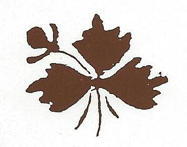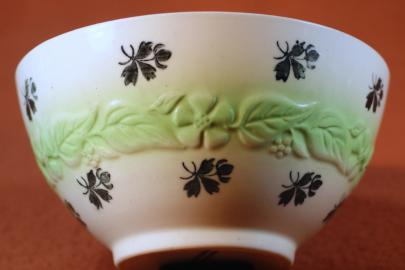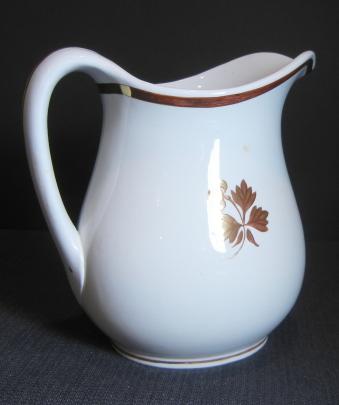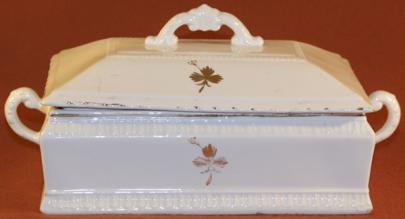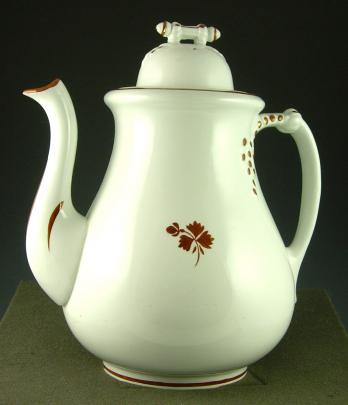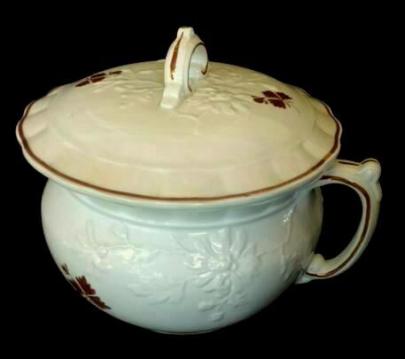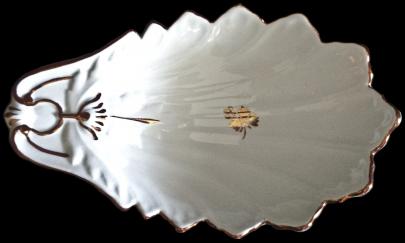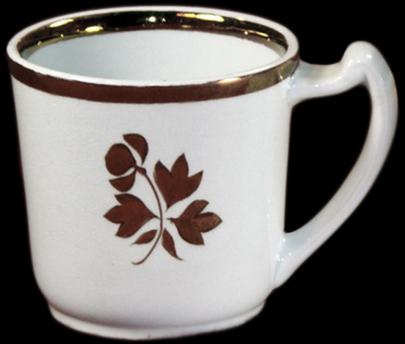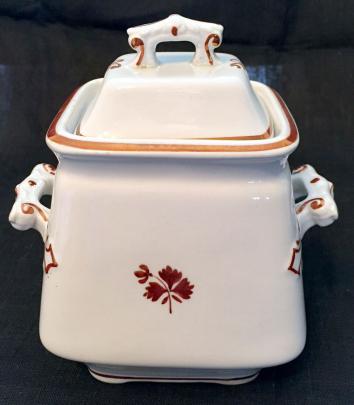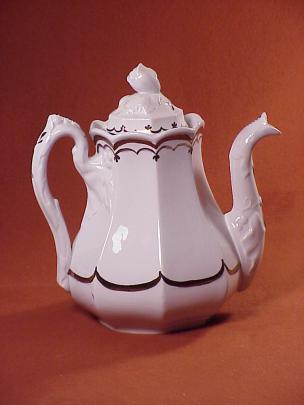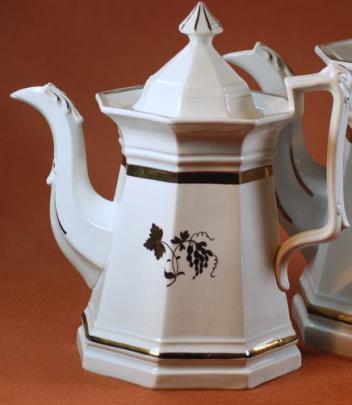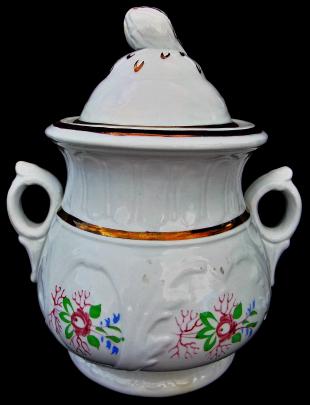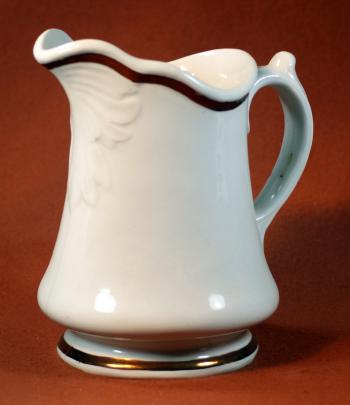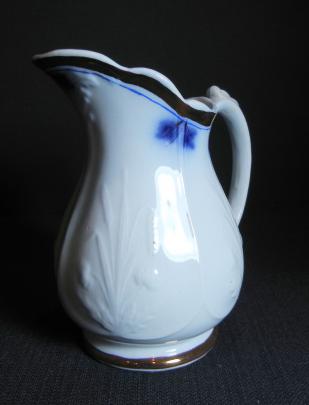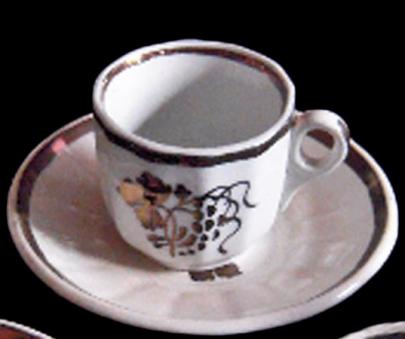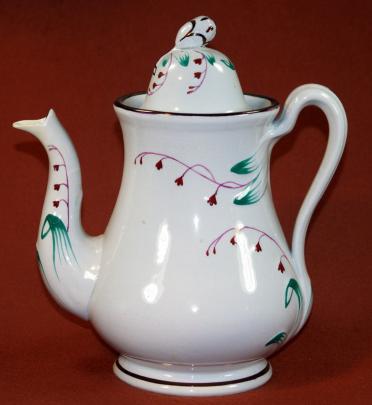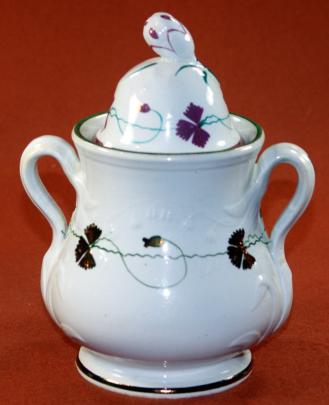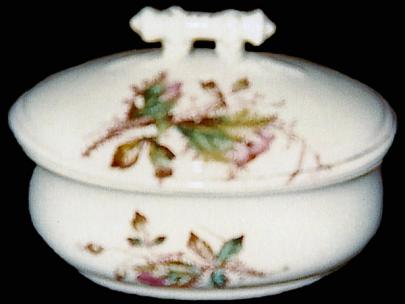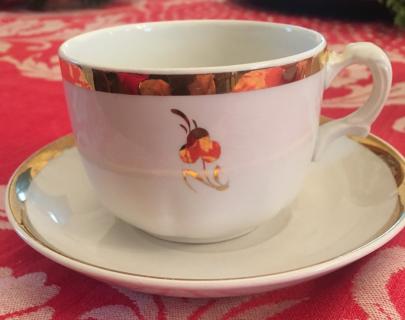Potter: William & Thomas Adams
Biography
Alternate Names: WIlliam Adams, William and Thormas Adams, W Adams and Co,. WIlliam Adams and Sons.
In business from 1829-1865
Location:
Tunstall, Staffordshire
Origins:
British
Manufacturing Era:
1840s, 1850s, 1860s
Type of Company:
Potter
Type of Ware:
Dinnerware
Treatments:
Copper Lustre
Body Styles:
Huron Shape
Vintage Shape
Motifs:
Tea Leaf
Adams, William & Thomas - Unknown - Unknown - No Available Photo
Item(s): N/A
Type(s) of Ware: N/A
Body Style: N/A
Collecting Category: N/A
Manufacturing Era: 1860s, 1870s, 1880s, 1890s
Treatment(s): N/A
Finials: N/A
Adults/Child's Pieces:
Footprints/Shapes: N/A
Motifs: N/A
Potter: William Adams
Biography
Alternate Names: WIlliam Adams, William and Thormas Adams, W Adams and Co,. WIlliam Adams and Sons.
In business from 1829-1865
Location:
Tunstall, Staffordshire
Origins:
British
Manufacturing Era:
1840s, 1850s, 1860s
Type of Company:
Potter
Type of Ware:
Dinnerware
Treatments:
Copper Lustre
Body Styles:
Huron Shape
Vintage Shape
Motifs:
Tea Leaf
William Adams - Huron - TL - Foot Bath
Description:
A spectacular and rare find.
Item(s): Foot Bath
Type(s) of Ware: Bath
Body Style: Huron Shape
Collecting Category: High-end
Manufacturing Era: 1850s
Treatment(s): Copper Lustre
Finials: N/A
Adults/Child's Pieces: Adult
Footprints/Shapes: Oval
Motifs: Tea Leaf
William Adams - Huron Shape - TL - Coffeepot/Teapot
Description:
An elegant Coffeepot/Teapot topped off with a ring finial.
Item(s): Coffeepot/Teapot
Type(s) of Ware: Dinnerware
Body Style: Huron Shape
Collecting Category: Mid-Level
Manufacturing Era: 1850s
Treatment(s): Copper Lustre
Finials: Ring
Adults/Child's Pieces: Adult
Footprints/Shapes: Round
Motifs: Tea Leaf
William Adams - Huron Shape - TL - Waste Jar - Master - 17 tall
Description:
This master waste jar would make quite an impressive addition to any collection. A rare find indeed. It stands 17 inches tall.
Item(s): Waste Jar (Master w/lid)
Type(s) of Ware: Bath
Body Style: Huron Shape
Collecting Category: High-end
Manufacturing Era: 1850s
Treatment(s): Copper Lustre
Finials: Ring
Adults/Child's Pieces: Adult
Footprints/Shapes: Round
Motifs: Tea Leaf
William Adams - Vintage Shape - TL - Plate
Description:
This plate is the only known example of Adams Vintage Shape decorated with a Tea Leaf. Printed mark: WIlliam Adams, Tunstall. Also has the name ADAMS impressed on the underside.
Item(s): Plate
Type(s) of Ware: Dinnerware
Body Style: Vintage Shape
Collecting Category: Mid-Level
Manufacturing Era: 1860s
Treatment(s): Copper Lustre
Finials: N/A
Adults/Child's Pieces: Adult
Footprints/Shapes: Round
Motifs: Tea Leaf
Potter: William Adams & Sons
Biography
20th Cewntury Tea Leaf potter. In business from 1963-1972 and famous for their Empress shape. Manufactured lots of unusual pieces not found in 19th century Tea Leaf like salt & pepper shakers, ash trays, jam jars, etc.
Location:
Tunstall and Stoke, Staffordshire
Origins:
British
Manufacturing Era:
20th Century Modern
Type of Company:
Potter
Type of Ware:
Dinnerware
Treatments:
Copper Lustre
Body Styles:
Empress Shape
Motifs:
Tea Leaf
Adams - Empress Shape - TL - Coffeepot/Teapot
Item(s): Coffeepot/Teapot
Type(s) of Ware: Dinnerware
Body Style: Empress Shape
Collecting Category: Common
Manufacturing Era: 20th Century Modern
Treatment(s): Copper Lustre
Finials: Domed Knob
Adults/Child's Pieces: Adult
Footprints/Shapes: Hexagon (6-Sided)
Motifs: Tea Leaf
Adams - Empress Shape - TL - Pitcher
Description:
Pitchers come in a variety of sizes.
Item(s): Pitcher/Jug
Type(s) of Ware: Dinnerware
Body Style: Empress Shape
Collecting Category: Common
Manufacturing Era: 20th Century Modern
Treatment(s): Copper Lustre
Finials: N/A
Adults/Child's Pieces: Adult
Footprints/Shapes: Hexagon (6-Sided)
Motifs: Tea Leaf
Adams - Empress Shape - TL - Sugar Bowl
Description:
A sugar bowl in the Empress shape.
Item(s): Sugar Bowl
Type(s) of Ware: Dinnerware
Body Style: Empress Shape
Collecting Category: Common
Manufacturing Era: 20th Century Modern
Treatment(s): Copper Lustre
Finials: Domed Knob
Adults/Child's Pieces: Adult
Footprints/Shapes: Hexagon (6-Sided)
Motifs: Tea Leaf
Potter: Henry Alcock
Biography
1861-1910; Added Ltd to their name in 1901
Location:
Cobridge, Staffordshire
Origins:
British
Manufacturing Era:
1880s, 1890s
Type of Company:
Potter
Type of Ware:
Dinnerware
Treatments:
Copper Lustre
Body Styles:
Blanket Stitch (Piecrust)
Jumbo
Plain Round
Square Ridged - Square Pear
Motifs:
Tea Leaf
Henry Alcock - Blanket Stitch - TL - Pitcher - 8.5 tall
Description:
This Blanket Stitch (or Piecrust) pitcher stands 8.5 inches tall.
Item(s): Pitcher/Jug
Type(s) of Ware: Dinnerware
Body Style: Blanket Stitch (Piecrust)
Collecting Category: Common
Manufacturing Era: 1880s, 1890s
Treatment(s): Copper Lustre
Finials: N/A
Adults/Child's Pieces: Adult
Footprints/Shapes: Oval
Motifs: Tea Leaf
Henry Alcock - Jumbo - TL - Coffeepot/Teapot
Description:
Very unusual to find decorated with Tea Leaf. Unusual elephant profile at peak of handle. Perhaps potted to commemorate Jumbo the elephant (ca. Christmas 1860 – September 15, 1885), the first international animal superstar, and the first African elephant to reach modern Europe alive. Jumbo lived in the London Zoo for about 16 years, where he delighted visitors by taking them on trips around the zoo grounds in the howdah on his back. Jumbo was the biggest elephant in captivity. Due to this, American showman P. T. Barnum wanted Jumbo in his circus, eventually buying the elephant in 1882 for $10,000. Jumbo's sale initiated public outrage inBritain, and drew notice around the world. The British objected to the sale, and wrote letters to Queen Victoria urging that Jumbo remain in London. The courts ruled in Barnum's favor however, and the elephant was shipped to the United States. "Jumbomania", a fad for all things Jumbo, was born at this time. The civilized world was flooded with Jumbo neckties, jewelry, soaps, and other ornaments and souvenirs (and maybe irtonstone?). Jumbo debuted in the United States on Easter Sunday 1882 at Madison Square Garden in New York City. His death was met with worldwide grief and sorrow.

Item(s): Coffeepot/Teapot
Type(s) of Ware: Dinnerware
Body Style: Jumbo
Collecting Category: Mid-Level
Manufacturing Era: 1880s
Treatment(s): Copper Lustre
Finials: Elephant
Adults/Child's Pieces: Adult
Footprints/Shapes: Round
Motifs: Tea Leaf
Type of Mark:
Type of Mark:
Stamped/Printed
Potter: American Crockery
Biography
In 1876 American Crockery company was producting white granite wares. The mark used was the English Lion & Unicorn with the initials of the company underneath it.
Location:
Trenton, New Jersey
Origins:
American
Manufacturing Era:
1870s, 1880s
Type of Company:
Potter
Type of Ware:
Dinnerware
Treatments:
Gold Lustre
Body Styles:
Unknown
Motifs:
Tea Leaf
American Crockery - Unknown - TL - No Available Photo
Item(s): N/A
Type(s) of Ware: Dinnerware
Body Style: N/A
Collecting Category: Common
Manufacturing Era: 1860s, 1870s, 1880s
Treatment(s): Gold Lustre
Finials: N/A
Adults/Child's Pieces: N/A
Footprints/Shapes: N/A
Motifs: Tea Leaf
Potter: John Bahl
Biography
Bahl Potteries, Inc. was in operation in 1940 and 1941 and only produced one known body style. The owner's prior work history included being a designer for Edwin M. Knowles Co. (1910) and a partner in an East Liverpool Ohio (ELO) decorating firm.
To date, the only known Tea Leaf pieces made by this potter are small bowls.
Location:
Carrolton, Ohio
Origins:
American
Manufacturing Era:
20th Century Modern
Type of Company:
Potter
Type of Ware:
Dinnerware
Treatments:
Gold Lustre
Body Styles:
Cameo Rose
Motifs:
Tea Leaf
Bahl China - Cameo Rose - TL - Bowl 2
Description:
A closer look at the unique embossed banding that decorates this small bowl. The pottery was only in business for one year and to-date small bowls are the only known pieces decorated with the tea leaf motif.
Item(s): Bowl (nested various sizes)
Type(s) of Ware: Dinnerware
Body Style: Cameo Rose
Collecting Category: Common
Manufacturing Era: 20th Century Modern
Treatment(s): Gold Lustre
Finials: N/A
Adults/Child's Pieces: Adult
Footprints/Shapes: Round
Motifs: Tea Leaf
Type of Mark:
Type of Mark:
Stamped/Printed
Potter: William Baker
Biography
Wm Baker - 1839-1932
Baker & Chetwynd - 1869-1875
Ltd. added 1893
Location:
Fenton, Staffordshire
Origins:
British
Manufacturing Era:
1860s, 1870s, 1880s, 1890s, 20th Century
Type of Company:
Potter
Type of Ware:
Dinnerware
Treatments:
Copper Lustre
Body Styles:
Draped Leaf
Motifs:
Morning Glory
Baker - Draped Leaf - MG - Coffeepot/Teapot
Description:
This potter was not a prolific producer of Tea Leaf wares.
Item(s): Coffeepot/Teapot
Type(s) of Ware: Dinnerware
Body Style: Draped Leaf
Collecting Category: Mid-Level
Manufacturing Era: 1870s, 1880s
Treatment(s): Copper Lustre
Finials: Gourd
Adults/Child's Pieces: Adult
Footprints/Shapes: Round
Motifs: Morning Glory
Baker - Draped Leaf - MG - Creamer
Description:
An elegant creamer in the draped leaf body style.
Item(s): Creamer
Type(s) of Ware: Dinnerware
Body Style: Draped Leaf
Collecting Category: Mid-Level
Manufacturing Era: 1870s, 1880s
Treatment(s): Copper Lustre
Finials: N/A
Adults/Child's Pieces: Adult
Footprints/Shapes: Round
Motifs: Morning Glory
Potter: Baker & Chetwynd
Biography
Wm Baker - 1839-1932
Baker & Chetwynd - 1869-1875
Ltd. added 1893
Location:
Burslem, Staffordshire
Origins:
British
Manufacturing Era:
1860s, 1870s
Type of Company:
Potter
Type of Ware:
Dinnerware
Treatments:
Copper Lustre
Body Styles:
Plain Round
Motifs:
Tea Leaf
Baker & Chetwynd - Plain Round - TL - Pitcher 6.75 in.
Description:
This is an example of Baker & Chetwynd in a beautiful table pitcher. It exudes teh simplicity of the Plain Round body styles.
Item(s): Pitcher/Jug
Type(s) of Ware: Dinnerware
Body Style: Plain Round
Collecting Category: Common
Manufacturing Era: 1860s, 1870s
Treatment(s): Copper Lustre
Finials: N/A
Adults/Child's Pieces: Adult
Footprints/Shapes: Oval
Motifs: Tea Leaf
Type of Mark:
Type of Mark:
Stamped/Printed
Potter: J. F. Barrow & Company
Biography
Barrow & Company 1853-1856
Location:
Longton, Staffodshire
Origins:
N/A
Manufacturing Era:
1850s
Type of Company:
Potter
Type of Ware:
Dinnerware
Treatments:
Copper Lustre
Body Styles:
N/A
Motifs:
Botanical
Barrow & Company - Unknown - Unknown - No Available Photo
Item(s): N/A
Type(s) of Ware: N/A
Body Style: N/A
Collecting Category: Common
Manufacturing Era: N/A
Treatment(s): N/A
Finials: N/A
Adults/Child's Pieces:
Footprints/Shapes: N/A
Motifs: N/A
Potter: Beardmore & Dawson
Biography
Also B&D
The Beardmore & Dawson firm was only in business for four months. There were other Beardmore partnerships, but the B & D mark is very rare indeed.
1863
Location:
N/A
Origins:
British
Manufacturing Era:
1860s
Type of Company:
Potter
Type of Ware:
Dinnerware
Treatments:
Copper Lustre
Body Styles:
Double Banded Loop
Panache
Unknown
Motifs:
Lustre Band
Beardmore & Dawson - Panache - LB - Coffeepot/Teapot
Description:
This Coffeepot/Teapot might be the very essence of the word panache - flamboyant confidence of style. Notice the bold outlined designs on the base and spout as well as the deep embossing.
Item(s): Coffeepot/Teapot
Type(s) of Ware: Dinnerware
Body Style: Panache
Collecting Category: Mid-Level
Manufacturing Era: 1860s
Treatment(s): Copper Lustre
Finials: Pomegranate
Adults/Child's Pieces: Adult
Footprints/Shapes: Round
Motifs: Lustre Band
Potter: Bennett
Biography
N/A
Location:
N/A
Origins:
N/A
Manufacturing Era:
N/A
Type of Company:
Potter
Type of Ware:
Dinnerware
Treatments:
Gold Lustre
Body Styles:
N/A
Motifs:
Moss Rose
Bennett - Unknown - MR - Syrup Pitcher
Description:
Ironstone syrup pitchers are hard-to-find. They have a metal lid and ironstone body. This one is decorated with the Moss Rose motif and gold lustre accents.
Item(s): Syrup Pitcher
Type(s) of Ware: Dinnerware
Body Style: Unknown
Collecting Category: Mid-Level
Manufacturing Era: N/A
Treatment(s): Gold Lustre
Finials: N/A
Adults/Child's Pieces: Adult
Footprints/Shapes: Round
Motifs: Moss Rose
Potter: Bishop & Stonier
Biography
Bishop & Stonier Ltd.
1891-1939
***See Powell & Bishop***
Location:
Hanley, Staffordshire
Origins:
British
Manufacturing Era:
1890s, 20th Century
Type of Company:
Potter
Type of Ware:
Bath, Dinnerware
Treatments:
Gold Lustre
Body Styles:
Chelsea
Golden Scroll
Square Ridged - Iona
Motifs:
Lustre Band
Tea Leaf
Bishop and Stonier - Chelsea - TL - Ewer and Basin
Description:
Wash bowl and Ewer
Item(s): Ewer and Basin
Type(s) of Ware: Bath
Body Style: Chelsea
Collecting Category: Common
Manufacturing Era: 1880s
Treatment(s): Gold Lustre
Finials: N/A
Adults/Child's Pieces: Adult
Footprints/Shapes: Round
Motifs: Tea Leaf
Potter: Blakeney Pottery Ltd
Biography
N/A
Location:
Stoke-on-Trent, Staffordshire
Origins:
British
Manufacturing Era:
20th Century Modern
Type of Company:
Potter
Type of Ware:
Dinnerware, Novelty
Treatments:
Copper Lustre
Body Styles:
Bamboo
Motifs:
Tea Leaf
Blakeney Pottery - Bamboo - TL - Invalid Feeder
Item(s): Other
Type(s) of Ware: Novelty
Body Style: Bamboo
Collecting Category: Mid-Level
Manufacturing Era: 20th Century Modern
Treatment(s): Copper Lustre
Finials: N/A
Adults/Child's Pieces: Adult
Footprints/Shapes: Round
Motifs: Tea Leaf
Potter: T&R Boote
Biography
Location:
Burslem, Staffordshire
Origins:
British
Manufacturing Era:
1870s, 1880s
Type of Company:
Potter
Type of Ware:
Dinnerware
Treatments:
Copper Lustre
Body Styles:
Classic Shape
Shield
Motifs:
Lustre Band
Moss Rose
Tea Leaf
Boote - Classic Shape - TL - Bone Dish
Item(s): Bone dish
Type(s) of Ware: Dinnerware
Body Style: Classic Shape
Collecting Category: Mid-Level
Manufacturing Era: 1870s
Treatment(s): Copper Lustre
Finials: N/A
Adults/Child's Pieces: Adult
Footprints/Shapes: Crescent
Motifs: Tea Leaf
Potter: Sampson Bridgwood
Biography
Alternate Names: Sampson Bridgwood and Son
Location:
Longton, Staffordshire
Origins:
British
Manufacturing Era:
1880s, 1890s
Type of Company:
Potter
Type of Ware:
Dinnerware
Treatments:
Gold Lustre
Body Styles:
Blanket Stitch (Piecrust)
Full Ribbed
Quilted Forget-Me-Not
Unknown
Motifs:
Cloverleaf
Tea Leaf
Bridgwood - Blanket Stitch - TL - Vegetable Tureen
Description:
Notice the medallion in the center of the finial.
Item(s): Vegetable tureen (covered - various sizes)
Type(s) of Ware: Dinnerware
Body Style: Blanket Stitch (Piecrust)
Collecting Category: Common
Manufacturing Era: 1880s, 1890s
Treatment(s): Gold Lustre
Finials: Arch - Elliptical
Adults/Child's Pieces: Adult
Footprints/Shapes: Rectangular
Motifs: Tea Leaf
Potter: Christian E. Brockmann
Biography
Brockmann Pottery Company was organized by Christian E. Brockmann in 1887. Originally the pottery was established by Messrs. Tempest, Brockmann & Co. in 1862 and used the English lion and unicorn mark with T. B. & Co. underneath. In 1881, the name was changed to Tempest, Brockmann & Sampson Pottery Co. After 1887 when it became Brockmann Pottery Co., the same English lion and unicorn mark was used; however, beneath the mark appeared the letters B. P. Co. The pottery was located in the West End of Cincinnati on Richmond Street. Mr.
Location:
Cincinnati, Ohio
Origins:
American
Manufacturing Era:
1880s, 1890s, 20th Century
Type of Company:
Potter
Type of Ware:
Dinnerware
Treatments:
Copper Lustre
Body Styles:
Cable Shape
Motifs:
Tea Leaf
Brockmann Pottery - Cable Shape - MR - Gravy Boat
Description:
A serving vessel for gravy and sauces. This one is decorated in a pretty Moss Rose motif.
Item(s): Gravy Boat
Type(s) of Ware: Dinnerware
Body Style: Cable Shape
Collecting Category: Common
Manufacturing Era: 1880s, 1890s, 20th Century
Treatment(s): Copper Lustre
Finials: N/A
Adults/Child's Pieces: Adult
Footprints/Shapes: Oval
Motifs: Moss Rose
Type of Mark:
Type of Mark:
Stamped/Printed
Potter: Broughham and Mayer
Biography
Location:
Sandyford, Tunstall, Staffordshire
Origins:
British
Manufacturing Era:
1850s, 1860s
Type of Company:
Potter
Type of Ware:
Dinnerware
Treatments:
Copper Lustre
Body Styles:
Augusta Shape
Classic Gothic
Motifs:
N/A
Brougham and Mayer - Classic Gothic - LB - Sauce Tureen
Description:
A sauce tureen in the simple, but elegant, Classic Gothic body style.
Item(s): Sauce Tureen
Type(s) of Ware: Dinnerware
Body Style: Classic Gothic
Collecting Category: Common
Manufacturing Era: 1850s, 1860s
Treatment(s): Copper Lustre
Finials: Mushroom
Adults/Child's Pieces: Adult
Footprints/Shapes: Hexagon (6-Sided)
Motifs: Lustre Band
Type of Mark:
Type of Mark:
Impressed
Potter: William Brunt
Biography
William Brunt, Jr. & Co. operated from 1865 to 1878. The founder began making white ware at the East Liverpool pottery in 1877. In 1878, his son William and son-in-law, Brad Louthan, joined him and the company name changed to William Brunt, Son & Co. It operated under this name until 1911.
Location:
East Liverpool, Ohio
Origins:
American
Manufacturing Era:
1860s, 1870s, 1880s, 1890s, 20th Century
Type of Company:
Potter
Type of Ware:
Bath, Dinnerware, Novelty
Treatments:
Gold Lustre
Body Styles:
Melon Rib
Plain Round
Simple Square
Motifs:
Moss Rose
Tea Leaf
Brunt - Melon Rib - MR - Syrup Pitcher - 8.5 inch
Description:
The ribbed throat on this piece identifies it as Melon Rib body style. The pewter lid and Moss Rose motif make this 8.5 inch syrup pitcher a wonderful decorative piece.
Item(s): Syrup Pitcher
Type(s) of Ware: Dinnerware
Body Style: Melon Rib
Collecting Category: Common
Manufacturing Era: 1860s, 1870s, 1880s, 1890s, 20th Century
Treatment(s): Gold Lustre
Finials: N/A
Adults/Child's Pieces: Adult
Footprints/Shapes: Round
Motifs: Moss Rose
Potter: Buffalo Pottery
Biography
Buffalo Pottery began operation in 1901 and continues to this day. It was organized by William J. Rhea, a former employee of Mayer China Company of Beaver Falls, Pennsylvania and of Trenton Potteries of Trenton, New Jersey. The company was originally founded to produce premiums for customers of Larkin Soap Company.
There is only one known piece of Buffalo Pottery adorned with the Tea Leaf motif. A photograph of the platter owned by author, Annise Heaivilin, appeared in her book Grandma's Tea Leaf Ironstone.
Location:
Buffalo, New York
Origins:
American
Manufacturing Era:
20th Century
Type of Company:
Potter
Type of Ware:
Dinnerware
Treatments:
Gold Lustre
Body Styles:
Unknown
Motifs:
Tea Leaf
Buffalo Pottery - Unknown - TL - No Available Photo
Description:
Pieces may be marked "Vassar."
Item(s): N/A
Type(s) of Ware: Dinnerware
Body Style: N/A
Collecting Category: Common
Manufacturing Era: 20th Century
Treatment(s): Gold Lustre
Finials: N/A
Adults/Child's Pieces: N/A
Footprints/Shapes: N/A
Motifs: Tea Leaf
Potter: Burford Brothers
Biography
Burford Brothers was founded by brothers Oliver, George and Robert Burford. This potter was in existence from 1882 to 1902. The pottery became known for the quality of its decorative work.
Location:
East Liverpool, Ohio
Origins:
American
Manufacturing Era:
1880s, 1890s, 20th Century
Type of Company:
Potter
Type of Ware:
Bath, Dinnerware
Treatments:
Gold Lustre
Body Styles:
Chelsea
Square Ridged - Bounty
Motifs:
Tea Leaf
Burford Brothers - Plain Round - TL - Bone Dish
Item(s): Bone dish
Type(s) of Ware: Dinnerware
Body Style: Plain Round
Collecting Category: Mid-Level
Manufacturing Era: 1880s
Treatment(s): Copper Lustre
Finials: N/A
Adults/Child's Pieces: Adult
Footprints/Shapes: Crescent
Motifs: Tea Leaf
Potter: Henry Burgess
Biography
pottery in business from 1864-1892.
Location:
Burslem, Staffordshire
Origins:
British
Manufacturing Era:
1860s, 1870s, 1880s, 1890s
Type of Company:
Potter
Type of Ware:
Bath, Dinnerware
Treatments:
Copper Lustre, Gold Lustre
Body Styles:
Bamboo
Cable Shape
Chrysanthemum
Embroidered Chelsea
Grenade Shape
Plain Round
Reeded Round
Scalloped Rim
Senate Shape
Simple Square - Pagoda
Simple Square
Square Ridged - Beaded Handle
Violet and Vine
Motifs:
Lustre Band
Tea Leaf
Burgess - Bamboo - TL - Pitcher
Description:
A 7 inch vessel for holding liquids
Item(s): Pitcher/Jug
Type(s) of Ware: Dinnerware
Body Style: Bamboo
Collecting Category: Common
Manufacturing Era: 1880s
Treatment(s): Copper Lustre
Finials: N/A
Adults/Child's Pieces: Adult
Footprints/Shapes: Rectangular, Square
Motifs: Tea Leaf
Type of Mark:
Type of Mark:
Stamped/Printed
Burgess - Cable Shape - TL - Coffeepot/Teapot
Description:
This is a Burgess Cable Coffeepot/Teapot. Notice the elaborate decorations emanating from the inside of the handle.
Item(s): Coffeepot/Teapot
Type(s) of Ware: Dinnerware
Body Style: Cable Shape
Collecting Category: Mid-Level
Manufacturing Era: 1870s, 1880s
Treatment(s): Copper Lustre
Finials: Rope/Cable (Ring 'n Cable)
Adults/Child's Pieces: Adult
Footprints/Shapes: Round
Motifs: Tea Leaf
Burgess - Chrysanthemum - TL - Chamber Pot
Description:
A lovely chamber pot in the Chrysanthemum shape.
Item(s): Chamber Pot
Type(s) of Ware: Bath
Body Style: Chrysanthemum
Collecting Category: Mid-Level
Manufacturing Era: 1880s
Treatment(s): Copper Lustre
Finials: Arch - Stepped
Adults/Child's Pieces: Adult
Footprints/Shapes: Round
Motifs: Tea Leaf
Burgess - Embroidered Chelsea - TL - Teapot
Description:
This body style is idetnified by the delicate embossing near the rims that resembles embroidery.
Item(s): Teapot (squatty)
Type(s) of Ware: Dinnerware
Body Style: Embroidered Chelsea
Collecting Category: Mid-Level
Manufacturing Era: 1880s
Treatment(s): Copper Lustre
Finials: Arch - Elliptical
Adults/Child's Pieces: Adult
Footprints/Shapes: Oval
Motifs: Tea Leaf
Burgess - Grenade Shape - TL - Relish-Pickle
Description:
This relish/pickle is dated to the 1860's. This piece is unusual because it is decorated with a Tea Leaf and copper lustre.
Item(s): Relish/pickle
Type(s) of Ware: Dinnerware
Body Style: Grenade Shape
Collecting Category: Mid-Level
Manufacturing Era: 1860s
Treatment(s): Copper Lustre
Finials: N/A
Adults/Child's Pieces: Adult
Footprints/Shapes: Other
Motifs: Tea Leaf
Burgess - Plain Round - TL - Mug
Description:
A modern shaped mug.
Item(s): Mug (Shaving - Various Sizes)
Type(s) of Ware: Bath
Body Style: Plain Round
Collecting Category: Common
Manufacturing Era: 1870s, 1880s, 1890s
Treatment(s): Copper Lustre
Finials: N/A
Adults/Child's Pieces: Adult
Footprints/Shapes: Round
Motifs: Tea Leaf
Burgess - Reeded Round - TL - Ewer
Description:
The graceful body and slim base make for a striking body style.
Item(s): Ewer
Type(s) of Ware: Bath
Body Style: Reeded Round
Collecting Category: Mid-Level
Manufacturing Era: 1870s, 1880s
Treatment(s): Copper Lustre
Finials: N/A
Adults/Child's Pieces: Adult
Footprints/Shapes: Round
Motifs: Tea Leaf
Burgess - Scalloped Rim - TL - Apple Bowl (scalloped) 9" dia by 6" tall
Description:
A beautiful Scalloped Rim apple bowl.
Item(s): Apple Bowl (scalloped)
Type(s) of Ware: Dinnerware
Body Style: Scalloped Rim
Collecting Category: Mid-Level
Manufacturing Era: 1870s, 1880s, 1890s
Treatment(s): Copper Lustre
Finials: N/A
Adults/Child's Pieces: Adult
Footprints/Shapes: Round
Motifs: Tea Leaf
Burgess - Simple Square - Pagoda - TL - Sugar Bowl
Description:
A sugar bowl with lid.
Item(s): Sugar Bowl
Type(s) of Ware: Dinnerware
Body Style: Simple Square - Pagoda
Collecting Category: Common
Manufacturing Era: 1880s
Treatment(s): Copper Lustre
Finials: Arch - Tudor
Adults/Child's Pieces: Adult
Footprints/Shapes: Rectangular
Motifs: Tea Leaf
Burgess - Square Ridged - Beaded Handle - TL - Sugar Bowl
Description:
A sugar bowl in the Square Ridged - Beaded Handle body style.
Item(s): Sugar Bowl
Type(s) of Ware: Dinnerware
Body Style: Square Ridged - Beaded Handle
Collecting Category: Mid-Level
Manufacturing Era: 1890s
Treatment(s): Copper Lustre
Finials: Arch - Stepped
Adults/Child's Pieces: Adult
Footprints/Shapes: Rectangular
Motifs: Tea Leaf
Burgess - Violet and Vine - TL - Pitcher - 9.5 inches tall
Description:
The handle is star of this pitcher. The body style name was derived from the Bird Foot Violet, a five petal flower with foliage resenbling the handle decoration.
Item(s): Pitcher/Jug
Type(s) of Ware: Dinnerware
Body Style: Violet and Vine
Collecting Category: Mid-Level
Manufacturing Era: 1870s, 1880s
Treatment(s): Copper Lustre
Finials: N/A
Adults/Child's Pieces: Adult
Footprints/Shapes: Oval
Motifs: Tea Leaf
Potter: Cartwright Bros.
Biography
Cartwright Bros. Pottery & Co. was founded by father, William Cartwright Sr., and sons Thomas, William, Jr. and Samuel. The pottery was in production between 1880 and 1927. Sometimes this pottery used a unique "lying down" Tea Leaf motif (named such by Annise Heaivilin).
Location:
East Liverpool, Ohio
Origins:
American
Manufacturing Era:
1880s, 1890s, 20th Century
Type of Company:
Potter
Type of Ware:
Bath, Dinnerware
Treatments:
Gold Lustre
Body Styles:
Plain Round
Simple Square - Pagoda
Simple Square
Unknown
Motifs:
Tea Leaf
Cartwright - Plain Round - TL - Bowl (Waste) - 4 in. tall, 6 in. dia_
Description:
A waste bowl in the plain round body style. This one is 4 inches tall and 6 inches in diameter.
Item(s): Bowl (waste)
Type(s) of Ware: Dinnerware
Body Style: Plain Round
Collecting Category: Common
Manufacturing Era: 1880s, 1890s
Treatment(s): Gold Lustre
Finials: N/A
Adults/Child's Pieces: Adult
Footprints/Shapes: Round
Motifs: Tea Leaf
Type of Mark:
Type of Mark:
Stamped/Printed
Potter: E&C Challinor
Biography
Alternate Names: E&C Challinor; Edward Challinor; C. Challinor
Challinor, Edward - 1854-1863
Challinor, E&C - 1862-1891
Challinor, C - 1892-1896
Location:
Lane Delph, Fenton
Origins:
British
Manufacturing Era:
1860s, 1870s, 1880s, 1890s
Type of Company:
Potter
Type of Ware:
Bath, Dinnerware
Treatments:
Copper Lustre
Body Styles:
Cable Shape
Corinthian
Old Empress
Victorian Beauty
Motifs:
Tea Leaf
Challinor - Cable Shape - TL - Shaving Mug
Description:
A shaving mug in the Cable body style.
Item(s): Mug (Shaving - Various Sizes)
Type(s) of Ware: Bath
Body Style: Cable Shape
Collecting Category: Mid-Level
Manufacturing Era: 1870s, 1880s
Treatment(s): Copper Lustre
Finials: N/A
Adults/Child's Pieces: Adult
Footprints/Shapes: Round
Motifs: Tea Leaf
Challinor - Scalloped Rim - TL - Bowl
Description:
The side view of the Challinor scalloped rim serving bowl. The prize (tea leaf motif) is on the inside.
Item(s): Bowl (nested various sizes)
Type(s) of Ware: Dinnerware
Body Style: Scalloped Rim
Collecting Category: Common
Manufacturing Era: 1870s, 1880s, 1890s, 20th Century
Treatment(s): Copper Lustre
Finials: N/A
Adults/Child's Pieces: Adult
Footprints/Shapes: Round
Motifs: Tea Leaf
Type of Mark:
Type of Mark:
Stamped/Printed
Challinor - Victorian Beauty - No Available Photo
Item(s): N/A
Type(s) of Ware: N/A
Body Style: Victorian Beauty
Collecting Category: Common
Manufacturing Era: N/A
Treatment(s): N/A
Finials: N/A
Adults/Child's Pieces:
Footprints/Shapes: N/A
Motifs: N/A
Potter: Chelsea China
Biography
Chelsea China Co. was in production between 1886 and 1896 (different sources state the opening was either a year before or a year after) but all agree it was in the late 1880s. While no founder names are available, Hugh Robertson was appointed manager whent the pottery opened. Sources say that the plant changed hands many times during its short history.
Location:
New Cumberland, West Virgnia
Origins:
American
Manufacturing Era:
1880s, 1890s
Type of Company:
Potter
Type of Ware:
Dinnerware
Treatments:
Gold Lustre
Body Styles:
Cable Shape
Fancy Pie Crust
Motifs:
Tea Leaf
Chelsea China - Cable Shape - TL - No Available Photo
Item(s): N/A
Type(s) of Ware: Dinnerware
Body Style: Cable Shape
Collecting Category: Common
Manufacturing Era: 1880s, 1890s
Treatment(s): Gold Lustre
Finials: N/A
Adults/Child's Pieces: Adult
Footprints/Shapes: N/A
Motifs: Tea Leaf
Chelsea China - Fancy Pie Crust - TL - No Available Photo
Item(s): N/A
Type(s) of Ware: Dinnerware
Body Style: Fancy Pie Crust
Collecting Category: Common
Manufacturing Era: 1880s, 1890s
Treatment(s): Gold Lustre
Finials: Arch - Elliptical
Adults/Child's Pieces: Adult
Footprints/Shapes: N/A
Motifs: Tea Leaf
Potter: Edward Clarke
Biography
Location:
Tunstall, Longport, Burslem
Origins:
British
Manufacturing Era:
1860s, 1870s, 1880s
Type of Company:
Potter
Type of Ware:
Bath, Dinnerware
Treatments:
Copper Lustre
Body Styles:
Plain Round
Motifs:
Tea Leaf
Edward Clarke - Plain Round - TL - Brush Vase
Description:
A Plain Round brush or toothbrush vase.
Item(s): Brush Vase/Toothbrush Vase
Type(s) of Ware: Bath
Body Style: Plain Round
Collecting Category: Mid-Level
Manufacturing Era: 1860s, 1870s, 1880s
Treatment(s): Copper Lustre
Finials: N/A
Adults/Child's Pieces: Adult
Footprints/Shapes: Round
Motifs: Tea Leaf
Potter: Joseph Clementson
Biography
1839-1864
See also: Clementson Bros.
Many of the body styles potted by J. Clementson were continued by Clementson Bros.
Location:
Shelton, Hanley, Staffordshire
Origins:
British
Manufacturing Era:
1840s, 1850s, 1860s
Type of Company:
Potter
Type of Ware:
Bath, Dinnerware
Treatments:
Copper Lustre, Copper Lustre with blue pinstripes and cobalt plumes, Copper Lustre with cobalt plumes, Copper Lustre with copper plumes, Gold Lustre, Polychrome with Copper Lustre
Body Styles:
Augusta Shape
Chinese Shape
Classic Gothic
Dallas Shape
Full Panelled Gothic
Grape Octagon
Hill Shape (Medallion Scroll)
Lafayette Shape
Lotus Bud
Nautilus
New York Shape
Panelled Grape
Plain Round
Prairie Shape
Ring Handled Round
Round Scallop
Motifs:
Botanical
Coral
Lustre Band
Seaweed
Teaberry
Other
Clementson - Augusta Shape - LB - Coffeepot/Teapot
Description:
Pouring vessel for hot liquids such as coffee or tea.
Item(s): Coffeepot/Teapot
Type(s) of Ware: Dinnerware
Body Style: Augusta Shape
Collecting Category: Mid-Level
Manufacturing Era: 1850s
Treatment(s): Copper Lustre with red and blue pinstripes and cobalt plumes
Finials: Fig
Adults/Child's Pieces: Adult
Footprints/Shapes: Octagon (8-Sided)
Motifs: Lustre Band
Clementson - Balanced Vine - TB - Basin - Reg 1867
Description:
A wash bowl or basin in the Balanced Vine body style. This body style was registered in 1867.
Item(s): Basin
Type(s) of Ware: Bath
Body Style: Balanced Vine
Collecting Category: Mid-Level
Manufacturing Era: 1860s
Treatment(s): Copper Lustre
Finials: N/A
Adults/Child's Pieces: Adult
Footprints/Shapes: Round
Motifs: Teaberry
Clementson - Chinese Shape - LB - Coffeepot/Teapot
Description:
No lustre decorates the finial and spout of this particular Coffeepot/Teapot.
Item(s): Coffeepot/Teapot
Type(s) of Ware: Dinnerware
Body Style: Chinese Shape
Collecting Category: Mid-Level
Manufacturing Era: 1850s
Treatment(s): Copper Lustre
Finials: Bud
Adults/Child's Pieces: Adult
Footprints/Shapes: Octagon (8-Sided)
Motifs: Lustre Band
Clementson - Full Panelled Gothic - TB - Coffeepot/Teapot
Description:
A Coffeepot/Teapot in the Full Panelled Gothic body style unmarked but probably made by Joseph Clementson.
Item(s): Coffeepot/Teapot
Type(s) of Ware: Dinnerware
Body Style: Full Panelled Gothic
Collecting Category: Mid-Level
Manufacturing Era: 1840s, 1850s
Treatment(s): Copper Lustre
Finials: Conical Knob
Adults/Child's Pieces: Adult
Footprints/Shapes: Octagon (8-Sided)
Motifs: Teaberry
Clementson - Heavy Square - TB - Ewer
Description:
An impressive ewer in the Heavy Square body style.
Item(s): Ewer
Type(s) of Ware: Bath
Body Style: Heavy Square
Collecting Category: Mid-Level
Manufacturing Era: 1880s
Treatment(s): Copper Lustre
Finials: N/A
Adults/Child's Pieces: Adult
Footprints/Shapes: Square
Motifs: Teaberry
Clementson - Hill Shape - LB - Sugar Bowl with Polychrome
Description:
A sugar bowl adorned with copper lustre and colorful floral decorations.
Item(s): Sugar Bowl
Type(s) of Ware: Dinnerware
Body Style: Hill Shape (Medallion Scroll)
Collecting Category: Mid-Level
Manufacturing Era: 1860s
Treatment(s): Polychrome with Copper Lustre
Finials: Fig
Adults/Child's Pieces: Adult
Footprints/Shapes: Round
Motifs: Lustre Band
Clementson - Lafayette Shape - LB - Cake Plate
Item(s): Cake Plate
Type(s) of Ware: Dinnerware
Body Style: Lafayette Shape
Collecting Category: High-end
Manufacturing Era: 1840s
Treatment(s): Copper Lustre with blue pinstripes and cobalt plumes
Finials: N/A
Adults/Child's Pieces: Adult
Footprints/Shapes: Round
Motifs: Lustre Band
Type of Mark:
Type of Mark:
Impressed
Clementson - Lafayette Shape - LB - Covered Veg
Description:
A beautiful covered vegetable adorned with brilliant copper lustre.
Item(s): Vegetable tureen (covered - various sizes)
Type(s) of Ware: Dinnerware
Body Style: Lafayette Shape
Collecting Category: Mid-Level
Manufacturing Era: 1860s
Treatment(s): Copper Lustre
Finials: Flower
Adults/Child's Pieces: Adult
Footprints/Shapes: Oval
Motifs: Lustre Band
Type of Mark:
Type of Mark:
Impressed
Clementson - Lafayette Shape - LB - Pitcher
Item(s): Pitcher/Jug
Type(s) of Ware: Dinnerware
Body Style: Lafayette Shape
Collecting Category: High-end
Manufacturing Era: 1840s
Treatment(s): Copper Lustre
Finials: N/A
Adults/Child's Pieces: Adult
Footprints/Shapes: Round
Motifs: Lustre Band
Clementson - Lafayette Shape - LB - Sauce Tureen Undertray
Item(s): Undertray (sauce)
Type(s) of Ware: Dinnerware
Body Style: Lafayette Shape
Collecting Category: High-end
Manufacturing Era: 1840s
Treatment(s): Copper Lustre
Finials: N/A
Adults/Child's Pieces: Adult
Footprints/Shapes: Oval
Motifs: Lustre Band
Type of Mark:
Type of Mark:
Impressed
Clementson - Nautilus - LB - Sauce Tureen.
Description:
Unusual and early body style. Note the dolphin handles on these interesting pieces. Ladle with this set may not be correct for this body style.
Item(s): Sauce Tureen
Type(s) of Ware: Dinnerware
Body Style: Nautilus
Collecting Category: Mid-Level
Manufacturing Era: 1840s, 1850s
Treatment(s): Copper Lustre
Finials: Dolphin Arch
Adults/Child's Pieces: Adult
Footprints/Shapes: Diamond Shaped
Motifs: Lustre Band
Clementson - New York Shape - LB - Chamber Pot
Description:
A chamber pot which is part of a bath set.
Item(s): Chamber Pot
Type(s) of Ware: Bath
Body Style: New York Shape
Collecting Category: Mid-Level
Manufacturing Era: 1850s
Treatment(s): Copper Lustre
Finials: Pod/Seed
Adults/Child's Pieces: Adult
Footprints/Shapes: Round
Motifs: Lustre Band
Clementson - Plain Round - TB - Egg Cup
Description:
Egg cups are treasured by collectors.
Item(s): Egg Cup
Type(s) of Ware: Dinnerware
Body Style: Plain Round
Collecting Category: High-end
Manufacturing Era: 1870s, 1880s, 1890s
Treatment(s): Copper Lustre
Finials: N/A
Adults/Child's Pieces: Adult
Footprints/Shapes: Round
Motifs: Teaberry
Clementson - Prairie Shape - LB - Pitcher 2 with cobalt line and plumes
Description:
Another view of the Prairie Shape pitcher.
Item(s): Pitcher/Jug
Type(s) of Ware: Dinnerware
Body Style: Prairie Shape
Collecting Category: Mid-Level
Manufacturing Era: 1860s
Treatment(s): Copper Lustre with blue pinstripes and cobalt plumes
Finials: N/A
Adults/Child's Pieces: Adult
Footprints/Shapes: Round
Motifs: Lustre Band
Potter: Clementson Bros.
Biography
Location:
Hanley, Staffordshire
Origins:
British
Manufacturing Era:
1860s, 1870s, 1880s, 1890s
Type of Company:
Potter
Type of Ware:
Bath, Dinnerware
Treatments:
Copper Lustre
Body Styles:
Balanced Vine
Beaded Band
Classic Gothic
Crystal Shape
Elegance
Grape Vine
Heavy Square
Lincoln Log
Plain Round
Scalloped Rim
Twelve Panel
Motifs:
Lustre Band
Tea Leaf
Teaberry
Clementson - Balanced Vine - TB - Ewer and Basin
Description:
Basin and Ewer.
Item(s): Ewer and Basin
Type(s) of Ware: Bath
Body Style: Balanced Vine
Collecting Category: High-end
Manufacturing Era: 1860s
Treatment(s): Copper Lustre
Finials: N/A
Adults/Child's Pieces: Adult
Footprints/Shapes: Round
Motifs: Teaberry
Clementson - Beaded Band - TB - Butter Dish - 3 pieces - 2
Description:
This is a three piece set with the unseen liner making it complete.
Item(s): Butter Dish
Type(s) of Ware: Dinnerware
Body Style: Beaded Band
Collecting Category: Mid-Level
Manufacturing Era: 1870s
Treatment(s): Copper Lustre
Finials: Arch - Circular
Adults/Child's Pieces: Adult
Footprints/Shapes: Round
Motifs: Teaberry
Clementson - Crystal Shape - TB - Butter Dish
Description:
A beautiful and complete butter dish inlcuding the insert with drain holes. Note that inside drainers rarely, if ever, had any motif design on them so that they could be used in a variety of wares.
Item(s): Drainer - Butter
Type(s) of Ware: Dinnerware
Body Style: Crystal Shape
Collecting Category: Common
Manufacturing Era: 1870s
Treatment(s): Copper Lustre
Finials: N/A
Adults/Child's Pieces: Adult
Footprints/Shapes: Round
Motifs: Lustre Band
Clementson - Crystal Shape - TL - Covered Vegetable
Description:
A plain but pleasant body style with uplift handles.
Item(s): Vegetable tureen (covered - various sizes)
Type(s) of Ware: Dinnerware
Body Style: Crystal Shape
Collecting Category: Common
Manufacturing Era: 1870s
Treatment(s): Copper Lustre
Finials: Knob
Adults/Child's Pieces: Adult
Footprints/Shapes: Oval
Motifs: Tea Leaf
Clementson - Elegance - TB - Ewer and Basin
Description:
Aptly named, this ewer and basin are very elegant.
Item(s): Ewer and Basin
Type(s) of Ware: Bath
Body Style: Elegance
Collecting Category: Mid-Level
Manufacturing Era: 1880s
Treatment(s): Copper Lustre
Finials: N/A
Adults/Child's Pieces: Adult
Footprints/Shapes: Round
Motifs: Teaberry
Type of Mark:
Type of Mark:
Stamped/Printed
Clementson - Grape Vine - TB - Soup Tureen
Description:
This is a stunning example of a rare item. To be complete the set would have an undertray and ladle.
Item(s): Soup Tureen
Type(s) of Ware: Dinnerware
Body Style: Grape Vine
Collecting Category: High-end
Manufacturing Era: 1880s
Treatment(s): Copper Lustre
Finials: Pretzel
Adults/Child's Pieces: Adult
Footprints/Shapes: Oval
Motifs: Teaberry
Clementson - Heavy Square - TB - Chamber Pot
Item(s): Chamber Pot
Type(s) of Ware: Bath
Body Style: Heavy Square
Collecting Category: High-end
Manufacturing Era: 1880s
Treatment(s): Copper Lustre
Finials: Heart - Open
Adults/Child's Pieces: Adult
Footprints/Shapes: Square
Motifs: Teaberry
Clementson - Plain Round - TB - Brush Vase with Undertray
Description:
A lovely brush vase decorated with the teaberry motif in a shape that was intended to go with many body styles.
Item(s): Brush Vase/Toothbrush Vase with Undertray
Type(s) of Ware: Bath
Body Style: Plain Round
Collecting Category: Mid-Level
Manufacturing Era: 1870s, 1880s, 1890s
Treatment(s): Copper Lustre
Finials: N/A
Adults/Child's Pieces: Adult
Footprints/Shapes: Round
Motifs: Teaberry
Clementson - Twelve Panel - TB - Child's Cup and Saucer
Description:
Child-sized version of Clementson's adult dinnerware.
Item(s): Cup and Saucer (Handled)
Type(s) of Ware: Dinnerware
Body Style: Twelve Panel
Collecting Category: High-end
Manufacturing Era: 1860s
Treatment(s): Copper Lustre
Finials: N/A
Adults/Child's Pieces: Child's
Footprints/Shapes: Round
Motifs: Teaberry
Potter: R. Cochran
Biography
The Cochran pottery of Glasgow, Scotland, utilized the same Pre-Tea Leaf design made famous by Edward Walley. Whether there was any connection between the Cochran and Walley potteries is not known. The long-lived Cochran pottery was in business from 1846 to 1918 while the Walley pottery was in production for only a few short years from 1845 to 1856.
Alt Name: R Cochran & Co.
Location:
Glasgow, Scotland
Origins:
British
Manufacturing Era:
1840s, 1850s, 1860s
Type of Company:
Potter
Type of Ware:
Dinnerware
Treatments:
Copper Lustre
Body Styles:
Arched Wheat
Hyacinth
Niagara Shape
Motifs:
Pre-Tea Leaf
Cochran - Arched Wheat - LB - Creamer
Description:
Pouring vessel (usually 4 to 5 inches in height). Part of coffee or tea set.
Item(s): Creamer
Type(s) of Ware: Dinnerware
Body Style: Arched Wheat
Collecting Category: Mid-Level
Manufacturing Era: 1840s, 1850s, 1860s, 1870s, 1880s, 1890s
Treatment(s): Copper Lustre
Finials: N/A
Adults/Child's Pieces: Adult
Footprints/Shapes: Round
Motifs: Lustre Band
Cochran - Hyacinth - LB - Coffeepot/Teapot - WIth Teal and Pink Polychrome Lustre
Description:
A hard-to-find piece. A Hyacinth Coffeepot/Teapot decorated with copper lustre and teal and pink decorations.
Item(s): Coffeepot/Teapot
Type(s) of Ware: Dinnerware
Body Style: Hyacinth
Collecting Category: Mid-Level
Manufacturing Era: 1860s
Treatment(s): Polychrome with Copper Lustre
Finials: Artichoke
Adults/Child's Pieces: Adult
Footprints/Shapes: Round
Motifs: Lustre Band
Cochran - Hyacinth - PRE - Sugar Bowl
Description:
A hard body style to find.
Item(s): Sugar Bowl
Type(s) of Ware: Dinnerware
Body Style: Hyacinth
Collecting Category: Mid-Level
Manufacturing Era: 1860s
Treatment(s): Copper Lustre
Finials: Artichoke
Adults/Child's Pieces: Adult
Footprints/Shapes: Round
Motifs: Pre-Tea Leaf
Cochran - Niagara Shape - No Available Photo
Item(s): N/A
Type(s) of Ware: N/A
Body Style: Niagara Shape
Collecting Category: N/A
Manufacturing Era: N/A
Treatment(s): N/A
Finials: N/A
Adults/Child's Pieces:
Footprints/Shapes: N/A
Motifs: N/A
Potter: Cook and Mareck
Biography
N/A
Location:
N/A
Origins:
N/A
Manufacturing Era:
N/A
Type of Company:
Potter
Type of Ware:
Bath
Treatments:
N/A
Body Styles:
Cable Shape
Motifs:
Moss Rose
Cook and Mareck - Cable Shape - MR - Soap Dish
Description:
This shape was created by many different potters. This soap dish would have also had a inside drainer.
Item(s): Soap Dish (Covered)
Type(s) of Ware: Bath
Body Style: Cable Shape
Collecting Category: Common
Manufacturing Era: 1870s, 1880s
Treatment(s): Gold Lustre
Finials: Rope/Cable (Ring 'n Cable)
Adults/Child's Pieces: Adult
Footprints/Shapes: Oval
Motifs: Moss Rose
Potter: Cork, Edge & Malkin
Biography
1860-1870
See: Edge Malkin
Location:
N/A
Origins:
British
Manufacturing Era:
N/A
Type of Company:
Potter
Type of Ware:
N/A
Treatments:
N/A
Body Styles:
N/A
Motifs:
N/A
Cork, Edge & Malkin - Bordered Fuchsia - TL - Vegetable Tureen
Item(s): Vegetable tureen (covered - various sizes)
Type(s) of Ware: Dinnerware
Body Style: Bordered Fuchsia
Collecting Category: High-end
Manufacturing Era: 1860s, 1870s
Treatment(s): Copper Lustre
Finials: Arch - Elliptical
Adults/Child's Pieces: Adult
Footprints/Shapes: Oval
Motifs: Tea Leaf
Potter: W & E Corn
Biography
formerly Edward Corn (1853-1863)
Location:
Burslem and Longport, Staffordshire
Origins:
British
Manufacturing Era:
1860s, 1870s, 1880s, 1890s
Type of Company:
Potter
Type of Ware:
Dinnerware
Treatments:
Copper Lustre, Gold Lustre
Body Styles:
Bellflower
Coronet
Ribboned Oak
Rope
Seashore (Plain)
Seashore (With Embossing)
Square Ridged - Square Pear
Woodland
Motifs:
Tea Leaf
Corn - Bellflower - TL - Creamer
Item(s): Creamer
Type(s) of Ware: Dinnerware
Body Style: Bellflower
Collecting Category: Mid-Level
Manufacturing Era: 1860s
Treatment(s): Copper Lustre
Finials: N/A
Adults/Child's Pieces: Adult
Footprints/Shapes: Rectangular
Motifs: Tea Leaf
Corn - Coronet - TL - Ewer and Basin
Description:
A elegant ewer and wash basin in the Coronet body style..
Item(s): Ewer and Basin
Type(s) of Ware: Bath
Body Style: Coronet
Collecting Category: Common
Manufacturing Era: 1880s
Treatment(s): Copper Lustre
Finials: N/A
Adults/Child's Pieces: Adult
Footprints/Shapes: Round
Motifs: Tea Leaf
Corn - Ribboned Oak - CL - Soap Box
Item(s): Soap Dish (Covered)
Type(s) of Ware: Bath
Body Style: Ribboned Oak
Collecting Category: Common
Manufacturing Era: 1870s
Treatment(s): Gold Lustre
Finials: Bow
Adults/Child's Pieces: Adult
Footprints/Shapes: Oval
Motifs: Cloverleaf
Corn - Square Ridged - Square Pear - MR - Coffeepot/Teapot
Description:
The motif on this Coffeepot/Teapot is a variant of the Moss Rose design.
Item(s): Coffeepot/Teapot
Type(s) of Ware: Dinnerware
Body Style: Square Ridged - Square Pear
Collecting Category: Mid-Level
Manufacturing Era: 1880s, 1890s
Treatment(s): Copper Lustre
Finials: Arch - Horizontal Flattened
Adults/Child's Pieces: Adult
Footprints/Shapes: Rectangular
Motifs: Moss Rose
Potter: Coxon & Co.
Biography
According to Marks of American Potters, Barber, 1904, Coxon & Co. was founded in 1863 by Charles Coxon and J. F. Thompson. Mr. Coxon, a modeler for Edwin and William Bennett, died in 1868 however the pottery continued to be operated by his widow and four sons after his death. Around 1884 the works were sold to Alpaugh & Magowan and renamed Empire Pottery.
Location:
Trenton, New Jersey
Origins:
American
Manufacturing Era:
1860s, 1870s, 1880s
Type of Company:
Potter
Type of Ware:
Bath
Treatments:
Gold Lustre
Body Styles:
Unknown
Motifs:
Moss Rose
Coxon - Unknown - MR - Ewer
Description:
A pretty Moss Rose decorated Ewer.
Item(s): Ewer
Type(s) of Ware: Bath
Body Style: Unknown
Collecting Category: Common
Manufacturing Era: N/A
Treatment(s): Gold Lustre
Finials: N/A
Adults/Child's Pieces: Adult
Footprints/Shapes: Round
Motifs: Moss Rose
Type of Mark:
Type of Mark:
Stamped/Printed
Potter: Crescent Pottery
Biography
Crescent Pottery (aka Cook & Hancock) was in operation from 1881 to 1906. It was founded by Charles H. Cook and W. S. Hancock. They organized and operated the pottery independently until 1892 when they joined with five other potteries to form the Trenton Potteries. These six potteries operated independently as well as part of the combined Trenton Potteries.
Location:
Trenton, New Jersey
Origins:
American
Manufacturing Era:
1880s, 1890s, 20th Century
Type of Company:
Potter
Type of Ware:
Dinnerware
Treatments:
Gold Lustre
Body Styles:
Unknown
Motifs:
Tea Leaf
Crescent Pottery - Severn - TL - Butter Dish
Description:
A butter dish with cover.
Item(s): Butter Dish
Type(s) of Ware: Dinnerware
Body Style: Severn
Collecting Category: Common
Manufacturing Era: 1880s, 1890s, 20th Century
Treatment(s): Copper Lustre
Finials: N/A
Adults/Child's Pieces: Adult
Footprints/Shapes: Round
Motifs: Tea Leaf
Potter: Crown Pottery
Biography
Crown Pottery began somewhere between 1892 and 1902. The pottery under a different name was built by A. M. Beck. After his death, a company taking the name Crown Pottery was formed. Amount 1900, the pottery combined with Peoria Pottery Co. of Peoria, Illinois to form Crown Pottery Inc.
To date the only known pieces decorated in gold lustre and the Tea Plum motif bearing this company's mark is a child's tea set.
Location:
Evansville, Indiana
Origins:
American
Manufacturing Era:
1890s, 20th Century
Type of Company:
Potter
Type of Ware:
Dinnerware
Treatments:
Gold Lustre
Body Styles:
Unknown
Motifs:
Tea Plum
Crown Pottery - Unknown - TL - No Available Photo
Item(s): N/A
Type(s) of Ware: Dinnerware
Body Style: N/A
Collecting Category: Common
Manufacturing Era: 1890s, 20th Century
Treatment(s): Gold Lustre
Finials: N/A
Adults/Child's Pieces: Child's
Footprints/Shapes: N/A
Motifs: Tea Leaf
Potter: Cumbow China Decorating
Biography
Cumbow China Decorating Co. (1932-1970) was founded by Jacob and Mabel (Cumbow) Ruskin in their home in Abingdon, Virginia. Mabel was the decorator. They purchased blanks of pottery, both American and English, and decorated them with a variety of lustre paint. The popularity of the pieces grew and in the 1940's the company moved from their home to a separate business. Of special interest to Tea Leaf collectors is the fact that Mabel Ruskin registered the Tea Leaf motif with the U.S. Patent Office.
Location:
Abingdon, Virginia
Origins:
American
Manufacturing Era:
20th Century Modern
Type of Company:
Decorator
Type of Ware:
Bath, Dinnerware, Novelty
Treatments:
Copper Lustre, Gold Lustre
Body Styles:
Unknown
Motifs:
Tea Leaf
Cumbow - Unknown - TL - Candleholder for Two Candles
Description:
A unique piece that would go with most Tea Leaf body styles.
Item(s): Candlestick
Type(s) of Ware: Novelty
Body Style: Unknown
Collecting Category: Common
Manufacturing Era: 20th Century Modern
Treatment(s): Copper Lustre
Finials: N/A
Adults/Child's Pieces: Adult
Footprints/Shapes: Oval
Motifs: Tea Leaf
Type of Mark:
Type of Mark:
Hand Painted
Potter: D & D China
Biography
Also known as D - D
Also known as Dale & Davis
Messrs. Dale & Davis established Prospect Hill Pottery in 1880 and manufactured semi-porcelain and white granite dinner and bath ware until 1894. Some marks included their full surnames Dale & Dales and later marks simply used their initials D & D.
Formerly: Isaac Davis 1872-1879
Subsequently: Cook Pottery Co. 1894-1959
Location:
Trenton, New Jersey
Origins:
American
Manufacturing Era:
1870s, 1880s, 1890s
Type of Company:
Potter
Type of Ware:
N/A
Treatments:
N/A
Body Styles:
Cable Shape
Motifs:
N/A
D and D - Cable Shape - MR - Gravy Boat
Description:
The distinctive rope ring at the top of the handle identifies this as Cable Shape.
Item(s): Gravy Boat
Type(s) of Ware: Dinnerware
Body Style: Cable Shape
Collecting Category: Common
Manufacturing Era: 1870s, 1880s
Treatment(s): Gold Lustre
Finials: N/A
Adults/Child's Pieces: Adult
Footprints/Shapes: Oval
Motifs: Moss Rose
Potter: Henry & William Davenport
Biography
Henry & William Davenport - 1835-1869
William & Davenport & Co - 1869-1881
Henry Davenport Ltd. - 1881-1897
Location:
Longport, Staffordshire
Origins:
British
Manufacturing Era:
1840s, 1850s, 1860s
Type of Company:
Potter
Type of Ware:
Bath, Dinnerware
Treatments:
Copper Lustre, Copper Lustre with added Pink Lustre
Body Styles:
Ceres Shape
Fig Cousin
Fig Union (Union Shape)
Gothic Cameo
Hebe Shape
Rondeau
Scalloped Rim
Motifs:
Lustre Band
Tea Leaf
Davenport - Fig Union (Union Shape) - LB - Gravy Boat
Item(s): Gravy Boat
Type(s) of Ware: Dinnerware
Body Style: Fig Union (Union Shape)
Collecting Category: High-end
Manufacturing Era: 1840s
Treatment(s): Copper Lustre
Finials: N/A
Adults/Child's Pieces: Adult
Footprints/Shapes: Oval
Motifs: Lustre Band
Type of Mark:
Type of Mark:
Davenport - Gothic Cameo - TL - Relish
Description:
Notice the beautifully embossed cameo in the handle.
Item(s): Relish/pickle
Type(s) of Ware: Dinnerware
Body Style: Gothic Cameo
Collecting Category: High-end
Manufacturing Era: 1840s
Treatment(s): Copper Lustre
Finials: N/A
Adults/Child's Pieces: Adult
Footprints/Shapes: Other
Motifs: Tea Leaf
Davenport - Hebe Shape - TL - Child's Sauce Tureen
Item(s): Sauce Tureen
Type(s) of Ware: Dinnerware
Body Style: Hebe Shape
Collecting Category: High-end
Manufacturing Era: 1840s
Treatment(s): Copper Lustre
Finials: Loop (Open)
Adults/Child's Pieces: Child's
Footprints/Shapes: Oval
Motifs: Tea Leaf
Davenport - Scalloped Rim - TL - Apple Bowl
Description:
Another view of the Davenport Scalloped Rim Apple bowl.
Item(s): Apple Bowl (scalloped)
Type(s) of Ware: Dinnerware
Body Style: Scalloped Rim
Collecting Category: Mid-Level
Manufacturing Era: 1870s, 1880s, 1890s
Treatment(s): Copper Lustre
Finials: N/A
Adults/Child's Pieces: Adult
Footprints/Shapes: Round
Motifs: Tea Leaf
Potter: Henry Davenport
Biography
SEE Davenport, Henry and Davenport, WilliamAlt Name: Henry Davenport Ltd.
Henry & William Davenport - 1835-1869
William & Davenport & Co - 1869-1881
Henry Davenport Ltd. - 1881-1897
Location:
N/A
Origins:
British
Manufacturing Era:
1880s
Type of Company:
Potter
Type of Ware:
N/A
Treatments:
N/A
Body Styles:
N/A
Motifs:
N/A
Henry Davenport - Unknown - Unknown - No Available Photo
Item(s): N/A
Type(s) of Ware: N/A
Body Style: N/A
Collecting Category: Common
Manufacturing Era: 1880s
Treatment(s): N/A
Finials: N/A
Adults/Child's Pieces:
Footprints/Shapes: N/A
Motifs: N/A
Potter: William Davenport
Biography
Alt Name: William Davenport & Company
Henry & William Davenport - 1835-1869
William & Davenport & Co - 1869-1881
Henry Davenport Ltd. - 1881-1897
Location:
Longport, Staffordshire
Origins:
British
Manufacturing Era:
1860s, 1870s, 1880s
Type of Company:
Potter
Type of Ware:
Bath, Dinnerware
Treatments:
Copper Lustre, Copper Lustre with added Pink Lustre
Body Styles:
Davenport's Ornate
Fig Cousin
Fig Union (Union Shape)
Gothic Cameo
Hebe Shape
Rondeau
Motifs:
Lustre Band
Tea Leaf
William Davenport - Fig Cousin - TL - Brush Vase with Undertray
Description:
A showy piece of ironstone that would delight nearly every collector especially when paired with its elusive tray. This brush vase is far fancier than its utilitarian use.
Item(s): Brush Vase/Toothbrush Vase with Undertray
Type(s) of Ware: Bath
Body Style: Fig Cousin
Collecting Category: Mid-Level
Manufacturing Era: 1860s
Treatment(s): Copper Lustre
Finials: N/A
Adults/Child's Pieces: Adult
Footprints/Shapes: Round
Motifs: Tea Leaf
William Davenport - Fig Cousin - TL - Creamer
Description:
Fig Cousin pieces with their pink and copper lustre make this pattern highly desireable.
Item(s): Creamer
Type(s) of Ware: Dinnerware
Body Style: Fig Cousin
Collecting Category: Mid-Level
Manufacturing Era: 1860s
Treatment(s): Copper Lustre with added Pink Lustre
Finials: N/A
Adults/Child's Pieces: Adult
Footprints/Shapes: Oval
Motifs: Tea Leaf
William Davenport - Rondeau - LB - Coffeepot/Teapot - Multi-Lustre Band
Description:
Notice all the bands of copper lustre on the tapered round body of this Coffeepot/Teapot.
Item(s): Coffeepot/Teapot
Type(s) of Ware: Dinnerware
Body Style: Rondeau
Collecting Category: Mid-Level
Manufacturing Era: 1870s
Treatment(s): Copper Lustre
Finials: Conical Knob
Adults/Child's Pieces: Adult
Footprints/Shapes: Round
Motifs: Lustre Band
William Davenport - Rondeau - TL - Brush Vase with Undertray
Description:
What lover of copper lustre doesn't like the extra band that Davenport uses to decorate its Rondeau pieces. This brush vase with tray makes a great addition to the bath set.
Item(s): Brush Vase/Toothbrush Vase with Undertray
Type(s) of Ware: Bath
Body Style: Rondeau
Collecting Category: Mid-Level
Manufacturing Era: 1870s
Treatment(s): Copper Lustre
Finials: N/A
Adults/Child's Pieces: Adult
Footprints/Shapes: Round
Motifs: Tea Leaf
William Davenport - Rondeau - TL - Coffeepot/Teapot
Description:
Notice the finial on this Coffeepot/Teapot which is unusual for the Rondeau shape.
Item(s): Coffeepot/Teapot
Type(s) of Ware: Dinnerware
Body Style: Rondeau
Collecting Category: Mid-Level
Manufacturing Era: 1870s
Treatment(s): Copper Lustre
Finials: Acorn
Adults/Child's Pieces: Adult
Footprints/Shapes: Round
Motifs: Tea Leaf
William Davenport - Rondeau - TL - Ewer
Description:
The tapered round body of this ewer is accentuated with thick copper lustre banding. A matching basin or wash bowl would complete the set.
Item(s): Ewer
Type(s) of Ware: Bath
Body Style: Rondeau
Collecting Category: Mid-Level
Manufacturing Era: 1870s
Treatment(s): Copper Lustre
Finials: N/A
Adults/Child's Pieces: Adult
Footprints/Shapes: Round
Motifs: Tea Leaf
William Davenport - Rondeau - TL - Vegetable Tureen
Description:
A elegant oval vegetable tureen in the Rondeau body style.
Item(s): Vegetable tureen (covered - various sizes)
Type(s) of Ware: Dinnerware
Body Style: Rondeau
Collecting Category: Mid-Level
Manufacturing Era: 1870s
Treatment(s): Copper Lustre
Finials: Conical Knob
Adults/Child's Pieces: Adult
Footprints/Shapes: Oval
Motifs: Tea Leaf
Potter: J. H. Davis
Biography
1875-1891
Alt Names: Davis, J. H. or Davis, J.
Location:
Eastwood, Hanley
Origins:
British
Manufacturing Era:
1870s, 1880s, 1890s
Type of Company:
Potter
Type of Ware:
Bath, Dinnerware
Treatments:
Copper Lustre
Body Styles:
Banded Round
Plain Round
Motifs:
Lustre Band
Teaberry
Davis, J H - Unknown - Unknown - No Available Photo
Item(s): N/A
Type(s) of Ware: N/A
Body Style: N/A
Collecting Category: N/A
Manufacturing Era: 1870s, 1880s, 1890s
Treatment(s): N/A
Finials: N/A
Adults/Child's Pieces:
Footprints/Shapes: N/A
Motifs: N/A
Potter: J. H. & J. Davis
Biography
1871-1875
See also J.H. Davis
Location:
Eastwood, Hanley
Origins:
British
Manufacturing Era:
1870s
Type of Company:
Potter
Type of Ware:
Dinnerware
Treatments:
Copper Lustre
Body Styles:
Banded Round
Motifs:
Lustre Band
Teaberry
J H and J Davis - Banded Round - TB - Coffeepot/Teapot
Description:
Vessel used for hot liquids such as coffee or tea.
Item(s): Coffeepot/Teapot
Type(s) of Ware: Dinnerware
Body Style: Banded Round
Collecting Category: Mid-Level
Manufacturing Era: 1870s, 1880s
Treatment(s): Copper Lustre
Finials: Conical Knob
Adults/Child's Pieces: Adult
Footprints/Shapes: Round
Motifs: Teaberry
Type of Mark:
Type of Mark:
Stamped/Printed
Potter: Dresden Pottery Works
Biography
According to Pottery Industries in East Liverpool Area 1910-1919 this American pottery was in business between 1912-1914 and then again between 1925-1927. In their early years they may have operated unter Brunt, Bloor, Martin & Co and the Potters Co-Operative Co.
Location:
East Liverpool, Ohio
Origins:
American
Manufacturing Era:
20th Century
Type of Company:
Potter
Type of Ware:
Dinnerware
Treatments:
Gold Lustre
Body Styles:
Chelsea
Motifs:
Moss Rose
Dresden - Chelsea - MR - Sugar Bowl
Description:
This sugar bowl has a large Moss Rose motif and gold lustre accents.
Item(s): Sugar Bowl
Type(s) of Ware: Dinnerware
Body Style: Chelsea
Collecting Category: Common
Manufacturing Era: 1880s
Treatment(s): Gold Lustre
Finials: Arch - Elliptical
Adults/Child's Pieces: Adult
Footprints/Shapes: Oval
Motifs: Moss Rose
Type of Mark:
Type of Mark:
Stamped/Printed
Potter: East End Pottery
Biography
East End Pottery was built with funds raised by subscriptions promoted by the East Liverpool Ohio Board of Trade. It was a cooperative composed of Edward Owens, Joseph Deekin, Sampson Turnbull and Gus Trenie. The pottery was in existence between 1894 and 1909. In 1909 the pottery was purchased by Gus Trenie and the pottery name was changed to Trenie China Co.
East End was one of the few potters of the time who used copper lustre rather than gold.
Location:
East Liverpool, Ohio
Origins:
American
Manufacturing Era:
1890s, 20th Century
Type of Company:
Potter
Type of Ware:
Bath, Dinnerware
Treatments:
Copper Lustre
Body Styles:
Plain Round
Simple Square - Beaded Handle
Motifs:
Tea Leaf
East End - Plain Round - TL - Child's Sugar Bowl
Item(s): Sugar Bowl
Type(s) of Ware: Dinnerware
Body Style: Plain Round
Collecting Category: Mid-Level
Manufacturing Era: 1890s, 20th Century
Treatment(s): Copper Lustre
Finials: Arch - Steeple
Adults/Child's Pieces: Child's
Footprints/Shapes: Round
Motifs: Tea Leaf
East End - Simple Square - Beaded Handle - TL - Creamer
Item(s): Creamer
Type(s) of Ware: Dinnerware
Body Style: Simple Square - Beaded Handle
Collecting Category: Common
Manufacturing Era: 1880s
Treatment(s): Copper Lustre
Finials: N/A
Adults/Child's Pieces: Adult
Footprints/Shapes: Rectangular
Motifs: Tea Leaf
Potter: Edge Malkin
Biography
1870-1903
Ltd. from 1897
Edge, Malkin & Co.
Potted both white ironstone as well as a cream-colored buttery color ironstone
Location:
Burslem, Staffordshire
Origins:
British
Manufacturing Era:
1870s, 1880s, 1890s
Type of Company:
Potter
Type of Ware:
Bath, Dinnerware
Treatments:
Copper Lustre
Body Styles:
Argyle
Polonaise
Motifs:
Tea Leaf
Edge Malkin - Polonaise - TL - Brush Vase
Description:
A rare find - a brush vase with a divided cavity topped with the handle.
Item(s): Brush Vase/Toothbrush Vase
Type(s) of Ware: Bath
Body Style: Polonaise
Collecting Category: High-end
Manufacturing Era: 1880s
Treatment(s): Copper Lustre
Finials: Rope/Cable (Ring 'n Cable)
Adults/Child's Pieces: Adult
Footprints/Shapes: Round
Motifs: Tea Leaf
Edge Malkin - Polonaise - TL - Cake Plate
Item(s): Cake Plate
Type(s) of Ware: Dinnerware
Body Style: Polonaise
Collecting Category: Mid-Level
Manufacturing Era: 1880s
Treatment(s): Copper Lustre
Finials: N/A
Adults/Child's Pieces: Adult
Footprints/Shapes: Square
Motifs: Tea Leaf
Edge Malkin - Polonaise - TL - Pancake Server
Description:
Edge Malkin's Polonaise is the color of pale Baltic amber.
Item(s): Pancake (covered)
Type(s) of Ware: Dinnerware
Body Style: Polonaise
Collecting Category: High-end
Manufacturing Era: 1880s
Treatment(s): Copper Lustre
Finials: Crown
Adults/Child's Pieces: Adult
Footprints/Shapes: Oval
Motifs: Tea Leaf
Type of Mark:
Type of Mark:
Stamped/Printed
Type of Mark:
Type of Mark:
Impressed
Potter: James Edwards
Biography
Alt Name: James Edwards & Son(s)
James Edwards 1842-1854
James Edards & Son(s) 1854-1883
Location:
Staffordshire
Origins:
British
Manufacturing Era:
1840s, 1850s
Type of Company:
Potter
Type of Ware:
Dinnerware
Treatments:
Copper Lustre
Body Styles:
Gothic Cameo
Motifs:
Lustre Band
James Edwards - Gothic Cameo - Unknown - No Available Photo
Item(s): N/A
Type(s) of Ware: Dinnerware
Body Style: Gothic Cameo
Collecting Category: Mid-Level
Manufacturing Era: 1840s, 1850s
Treatment(s): Copper Lustre
Finials: N/A
Adults/Child's Pieces:
Footprints/Shapes: N/A
Motifs: N/A
Potter: John Edwards
Biography
In business 1847-1900; appears to have made Tea Leaf only in the 1870s and 1880s.
Location:
Fenton, Staffordshire
Origins:
British
Manufacturing Era:
1870s, 1880s
Type of Company:
Potter
Type of Ware:
Dinnerware
Treatments:
Copper Lustre
Body Styles:
Camille
Chelsea
Peerless Shape (Feather)
Plain Round
Royal Shape
Tuscan Shape
Victory Shape (Dolphin)
Motifs:
Tea Leaf
John Edwards - Camille - TL - Ewer
Description:
A lovely ewer with soft fluting that rises up from the base and cascades down from the rim.
Item(s): Ewer
Type(s) of Ware: Bath
Body Style: Camille
Collecting Category: Mid-Level
Manufacturing Era: 1880s
Treatment(s): Copper Lustre
Finials: N/A
Adults/Child's Pieces: Adult
Footprints/Shapes: Round
Motifs: Tea Leaf
John Edwards - Peerless Shape - TL - Ewer and Basin
Description:
Peerless is also referred to as "Feather" for the embossed feather design.
Item(s): Ewer and Basin
Type(s) of Ware: Bath
Body Style: Peerless Shape (Feather)
Collecting Category: Mid-Level
Manufacturing Era: 1880s
Treatment(s): Copper Lustre
Finials: N/A
Adults/Child's Pieces: Adult
Footprints/Shapes: Rectangular, Round
Motifs: Tea Leaf
John Edwards - Royal Shape - TL - Creamer 1
Description:
A rare example of the Royal Shape decorated with the Tea Leaf motif. This creamer has a bulbous body with leaf embossing at the handle terminals. Notice the lion's face on the tip of the handle.
Item(s): Creamer
Type(s) of Ware: Dinnerware
Body Style: Royal Shape
Collecting Category: High-end
Manufacturing Era: 1870s
Treatment(s): Copper Lustre
Finials: N/A
Adults/Child's Pieces: Adult
Footprints/Shapes: Round
Motifs: Tea Leaf
John Edwards - Victory Shape - TL - Ewer and Basin
Description:
Note the dolphin that graced the tip of the Ewer handle.
Item(s): Ewer and Basin
Type(s) of Ware: Bath
Body Style: Victory Shape (Dolphin)
Collecting Category: Mid-Level
Manufacturing Era: 1880s
Treatment(s): Copper Lustre
Finials: N/A
Adults/Child's Pieces: Adult
Footprints/Shapes: Round
Motifs: Tea Leaf
Potter: Edwards Brothers
Biography
N/A
Location:
Fenton, England
Origins:
British
Manufacturing Era:
N/A
Type of Company:
Potter
Type of Ware:
Bath
Treatments:
Gold Lustre
Body Styles:
Peerless Shape (Feather)
Plain Round
Victory Shape (Dolphin)
Motifs:
Moss Rose
Edwards Brothers - Peerless Shape - MR - Brush Vase
Description:
A brush vase is a welcome addition to any bath set. This particular one is decorated with a delicate Moss Rose motif.
Item(s): Brush Vase/Toothbrush Vase
Type(s) of Ware: Bath
Body Style: Peerless Shape (Feather)
Collecting Category: Mid-Level
Manufacturing Era: 1880s
Treatment(s): Gold Lustre
Finials: N/A
Adults/Child's Pieces: Adult
Footprints/Shapes: Oblong
Motifs: Moss Rose
Type of Mark:
Type of Mark:
Stamped/Printed
Potter: Thomas Elsmore
Biography
1872-1887
Also Thomas Elsmore & Son
Location:
Tunstall, Staffordshire
Origins:
British
Manufacturing Era:
1870s, 1880s
Type of Company:
Potter
Type of Ware:
Bath, Dinnerware
Treatments:
Copper Lustre
Body Styles:
Delphi
Ginger-Jar Round
Plain Round
Unknown
Motifs:
Tea Leaf
Thomas Elsmore - Delphi - TL - Covered Vegetable
Description:
A covered serving dish.
Item(s): Vegetable tureen (covered - various sizes)
Type(s) of Ware: Dinnerware
Body Style: Delphi
Collecting Category: Mid-Level
Manufacturing Era: 1880s
Treatment(s): Copper Lustre
Finials: Arch - Horizontal Flattened
Adults/Child's Pieces: Adult
Footprints/Shapes: Oval
Motifs: Tea Leaf
Potter: Elsmore and Forster
Biography
Sometimes printed as Elsmore & Foster on Columbia Shape children's pieces.
Location:
Tunstall, Staffordshire
Origins:
British
Manufacturing Era:
1850s, 1860s, 1870s
Type of Company:
Potter
Type of Ware:
Bath, Dinnerware
Treatments:
Copper Lustre, Copper Lustre with cobalt plumes, Copper Lustre with copper plumes, Green and Gold, Polychrome with Copper Lustre
Body Styles:
Arched Forget-Me-Not
Ceres Shape
Columbia Shape
Crystal Shape
Fanfare
Laurel Wreath
Panelled Decagon
Portland Shape
Tulip Shape (Little Scroll)
Motifs:
Lustre Band
Morning Glory
Pepperleaf
Reverse Teaberry
Teaberry
Tobacco Leaf
Elsmore and Forster - Arched Forget Me Not - LB - Coffeepot/Teapot
Description:
Vessel for hot liquids such as coffee or tea. This piece is not marked but it is attributed to Elsmore & Forster. Note Forget-Me-Not embossing on this piece.
Item(s): Coffeepot/Teapot
Type(s) of Ware: Dinnerware
Body Style: Arched Forget-Me-Not
Collecting Category: Mid-Level
Manufacturing Era: 1860s
Treatment(s): Copper Lustre
Finials: Conical Knob
Adults/Child's Pieces: Adult
Footprints/Shapes: Round
Motifs: Lustre Band
Elsmore and Forster - Ceres Shape - LB - Sauce Tureen
Description:
Shown with undertray.
Item(s): Sauce Tureen
Type(s) of Ware: Dinnerware
Body Style: Ceres Shape
Collecting Category: Mid-Level
Manufacturing Era: 1850s
Treatment(s): Copper Lustre
Finials: Ring
Adults/Child's Pieces: Adult
Footprints/Shapes: Round
Motifs: Lustre Band
Elsmore and Forster - Columbia Shape - MG - Child's Coffeepot/Teapot
Description:
Children's sets are a favorite among collectors.
Item(s): Coffeepot/Teapot
Type(s) of Ware: Dinnerware
Body Style: Columbia Shape
Collecting Category: High-end
Manufacturing Era: 1850s
Treatment(s): Copper Lustre
Finials: Mushroom
Adults/Child's Pieces: Child's
Footprints/Shapes: Round
Motifs: Morning Glory
Elsmore and Forster - Crystal Shape - PEP - Sugar Bowl
Description:
A Crystal shape sugar by Elsmore & Forster with scalloped rim.
Item(s): Sugar Bowl
Type(s) of Ware: Dinnerware
Body Style: Crystal Shape
Collecting Category: Mid-Level
Manufacturing Era: 1870s
Treatment(s): Copper Lustre
Finials: Conical Knob
Adults/Child's Pieces: Adult
Footprints/Shapes: Round
Motifs: Pepperleaf
Elsmore and Forster - Fanfare - TOB - Chamber Pot
Description:
A covered vessel used for personal hygiene.
Item(s): Chamber Pot
Type(s) of Ware: Bath
Body Style: Fanfare
Collecting Category: Mid-Level
Manufacturing Era: 1860s
Treatment(s): Copper Lustre
Finials: Domed Knob
Adults/Child's Pieces: Adult
Footprints/Shapes: Round
Motifs: Tobacco Leaf
Elsmore and Forster - Fanfare - TOB - Sauce Tureen
Description:
A covered vessel with ladle and undertray to contain and dispense sauces.
Item(s): Sauce Tureen
Type(s) of Ware: Dinnerware
Body Style: Fanfare
Collecting Category: Mid-Level
Manufacturing Era: 1860s
Treatment(s): Copper Lustre
Finials: Domed Knob
Adults/Child's Pieces: Adult
Footprints/Shapes: Oval
Motifs: Tobacco Leaf
Elsmore and Forster - Laurel Wreath - LB - Vegetable Tureen
Description:
This vegetable bowl is a stunning example of the brilliant copper lustre that adorns pieces in the Laurel Wreath body style.
Item(s): Vegetable tureen (covered - various sizes)
Type(s) of Ware: Dinnerware
Body Style: Laurel Wreath
Collecting Category: High-end
Manufacturing Era: 1860s
Treatment(s): Copper Lustre
Finials: Knot
Adults/Child's Pieces: Adult
Footprints/Shapes: Oval
Motifs: Lustre Band
Elsmore and Forster - Unknown - PEP - Foot Bath
Description:
An extremely hard piece to find. A foot bath attributed to Elsmore & Forster.
Item(s): Foot Bath
Type(s) of Ware: Bath
Body Style: Unknown
Collecting Category: High-end
Manufacturing Era: N/A
Treatment(s): Copper Lustre
Finials: N/A
Adults/Child's Pieces: Adult
Footprints/Shapes: Oblong
Motifs: Pepperleaf
Elsmore and Forster - Unknown - TOB - Spittoon/Cuspidor
Description:
A spittoon decorated with the tobacco leaf motif. Note the flashy drain ornamentation resembling a lion or gargoyle.
Item(s): Spittoon/Cuspidor
Type(s) of Ware: Bath
Body Style: Unknown
Collecting Category: Mid-Level
Manufacturing Era: N/A
Treatment(s): Copper Lustre
Finials: N/A
Adults/Child's Pieces: Adult
Footprints/Shapes: Round
Motifs: Tobacco Leaf
Potter: Etruria Pottery
Biography
William Bloor founded Bloor, Ott & Booth in 1863 which operated under that name until 1865. Then the company became known as Ott, Brewer & Bloor from 1865-t0 1870. Then, in 1870 in the hopes of capitalizing on the popularity of English ironstone and earthenware, the factory was named Etruria Works and the company was known as Etruria Pottery & Co. (of Ott & Brewer Co.). This company was in operation until 1893.
Location:
Trenton, New Jersey
Origins:
American
Manufacturing Era:
1860s, 1870s, 1880s, 1890s
Type of Company:
Potter
Type of Ware:
Bath
Treatments:
Gold Lustre
Body Styles:
Cable Shape
Motifs:
Moss Rose
Etruria Pottery - Cable Shape - MR - Hot Water Pitcher
Description:
Hot water pitchers have a longer, more sleek neck than pitchers in the same body style. They are a hard-to-find item.
Item(s): Hot Water/Service Pitcher
Type(s) of Ware: Bath
Body Style: Cable Shape
Collecting Category: Mid-Level
Manufacturing Era: 1870s, 1880s
Treatment(s): Gold Lustre
Finials: N/A
Adults/Child's Pieces: Adult
Footprints/Shapes: Round
Motifs: Moss Rose
Potter: John Farrall
Biography
1854
Also Jacob Farrall & Co.
(Pearson, Farrall & Meakin)
Location:
Shelton, Hanley, Staffordshire
Origins:
British
Manufacturing Era:
1850s
Type of Company:
Potter
Type of Ware:
Dinnerware
Treatments:
Copper Lustre
Body Styles:
Dangling Tulips
Grape Octagon
Motifs:
Lustre Band
Farrall - Dangling Tulips - LB - Relish-Pickle
Description:
A relish or pickle dish in the Dangling Tulips body style.
Item(s): Relish/pickle
Type(s) of Ware: Dinnerware
Body Style: Dangling Tulips
Collecting Category: Mid-Level
Manufacturing Era: 1850s
Treatment(s): Copper Lustre
Finials: N/A
Adults/Child's Pieces: Adult
Footprints/Shapes: Oval
Motifs: Lustre Band
Potter: Fell and Thropp
Biography
Fell and Thropp Co. was founded by Samuel Thropp and J. Hart Brewer. The company was previously named Fell and Brewer. There is no mention of who might have been Mr. Fell. This was the first pottery in Trenton, New Jersey to produce whiteware.
The unusual large, spiky leafed Tea Leaf motif has been found on several other potters (such as John Moses of Glasgow Pottery). There were three decorating services in Trenton at this time, and these potteries may have all used them.
Location:
Trenton, New Jersey
Origins:
American
Manufacturing Era:
1870s, 1880s, 1890s, 20th Century
Type of Company:
Potter
Type of Ware:
Dinnerware
Treatments:
Gold Lustre
Body Styles:
Cable Shape
Motifs:
Tea Leaf
Fell & Thropp - Cable Shape - TL - No Available Photo
Item(s): N/A
Type(s) of Ware: Dinnerware
Body Style: Cable Shape
Collecting Category: Common
Manufacturing Era: 1870s, 1880s, 1890s
Treatment(s): Gold Lustre
Finials: N/A
Adults/Child's Pieces: N/A
Footprints/Shapes: N/A
Motifs: Tea Leaf
Potter: Ford China
Biography
Ford China Co. was founded in 1898 by John Wick, Jr. and Captain John B. Ford for whom the town where the factory was located was named. Later on the pottery came into the hands of Pennsylvania China Co. "Turin" may have been the body style name for their tea leaf wares.
Location:
Ford City, Pennsylvania
Origins:
American
Manufacturing Era:
1890s, 20th Century
Type of Company:
Potter
Type of Ware:
Bath, Dinnerware
Treatments:
Gold Lustre
Body Styles:
Unknown
Motifs:
Tea Leaf
Ford City - Turin - TL - No Available Photo
Item(s): N/A
Type(s) of Ware: Bath, Dinnerware
Body Style: Turin
Collecting Category: Common
Manufacturing Era: 1890s, 20th Century
Treatment(s): Gold Lustre
Finials: N/A
Adults/Child's Pieces: Adult
Footprints/Shapes: Oval
Motifs: Tea Leaf
Potter: Jacob Furnival
Biography
1845-1870
Also Jacob Furnival & Co.
Location:
Colbridge, Staffordshire
Origins:
British
Manufacturing Era:
1840s, 1850s, 1860s, 1870s
Type of Company:
Potter
Type of Ware:
Bath, Dinnerware
Treatments:
Copper Lustre
Body Styles:
Berry Cluster
Classic Gothic
Cockscomb Handle
Full Panelled Gothic
Gothic Grape
Grand Loop
Grape Octagon
Hidden Motif
Loop & Line
Panelled Grape
Primary
Quartered Rose
Scalloped Rim
Unknown
Walled Octagon
Wheat
Motifs:
Blackberry
Botanical
Chelsea Grape
Cinquefoil
Coral
Ivy
Lustre Band
Pinwheel
Teaberry
Jacob Furnival (Attrib.) - Panelled Grape - CINQ - Coffeepot/Teapot
Description:
A graceful bulbous body style with embossed grape leaves at the handle terminal and spreading from the finial.
Item(s): Coffeepot/Teapot
Type(s) of Ware: Dinnerware
Body Style: Panelled Grape
Collecting Category: Mid-Level
Manufacturing Era: 1860s
Treatment(s): Copper Lustre
Finials: Ring
Adults/Child's Pieces: Adult
Footprints/Shapes: Oval
Motifs: Cinquefoil
Jacob Furnival - Berry Cluster - LB - Cake Plate
Description:
Tall embossed stalks with leaves and berries at the upper ends deliniate the sections of this body style. Cake plates are a favorite among collectors. This piece is attributed to Jacob Furnival.
Item(s): Cake Plate
Type(s) of Ware: Dinnerware
Body Style: Berry Cluster
Collecting Category: Mid-Level
Manufacturing Era: 1850s
Treatment(s): Copper Lustre
Finials: N/A
Adults/Child's Pieces: Adult
Footprints/Shapes: Other
Motifs: Lustre Band
Jacob Furnival - Cockscomb Handle - Polychrome with CL Seaweed - Sugar Bowl
Description:
A highly decorated sugar bowl with copper lustre and blue seaweed motif. This cockcomb handled piece is unmarked but attributed to Jacob Furnival.
Item(s): Sugar Bowl
Type(s) of Ware: Dinnerware
Body Style: Cockscomb Handle
Collecting Category: High-end
Manufacturing Era: 1840s
Treatment(s): Polychrome with Copper Lustre
Finials: Mushroom
Adults/Child's Pieces: Adult
Footprints/Shapes: Hexagon (6-Sided)
Motifs: Seaweed
Jacob Furnival - Grand Loop - CINQ - Coffeepot/Teapot
Description:
This particular Coffeepot/Teapot is deeply embossed.
Item(s): Coffeepot/Teapot
Type(s) of Ware: Dinnerware
Body Style: Grand Loop
Collecting Category: Mid-Level
Manufacturing Era: 1860s
Treatment(s): Copper Lustre
Finials: Pod/Seed
Adults/Child's Pieces: Adult
Footprints/Shapes: Round
Motifs: Cinquefoil
Jacob Furnival - Hidden Motif - BOT - Hot Water
Description:
A vessel used to carry hot water. While this piece is unmarked, the body style and motif are attributed to Jacob Furnival.
Item(s): Hot Water/Service Pitcher
Type(s) of Ware: Bath
Body Style: Hidden Motif
Collecting Category: High-end
Manufacturing Era: 1860s
Treatment(s): Copper Lustre
Finials: N/A
Adults/Child's Pieces: Adult
Footprints/Shapes: Round
Motifs: Botanical
Jacob Furnival - Primary - No Available Photo
Item(s): N/A
Type(s) of Ware: N/A
Body Style: Primary
Collecting Category: N/A
Manufacturing Era: N/A
Treatment(s): N/A
Finials: N/A
Adults/Child's Pieces:
Footprints/Shapes: N/A
Motifs: N/A
Jacob Furnival - Quartered Rose - PIN - Sugar Bowl
Description:
A highly decorated sugar bowl in the Quartered Rose body style.
Item(s): Sugar Bowl
Type(s) of Ware: Dinnerware
Body Style: Quartered Rose
Collecting Category: Mid-Level
Manufacturing Era: 1860s
Treatment(s): Copper Lustre
Finials: Bud
Adults/Child's Pieces: Adult
Footprints/Shapes: Round
Motifs: Pinwheel
Jacob Furnival - Walled Octagon - CG - Brush Box
Description:
A brush vase is a treasured addition to any bath set. This particular one is not marked but it is attibuted to Jacob Furnival.
Item(s): Brush/Razor/Utility Horizontal Box
Type(s) of Ware: Bath
Body Style: Walled Octagon
Collecting Category: High-end
Manufacturing Era: 1860s
Treatment(s): Copper Lustre
Finials: Knob
Adults/Child's Pieces: Adult
Footprints/Shapes: Rectangular
Motifs: Chelsea Grape
Jacob Furnival - Wheat - CINQ - Coffeepot/Teapot
Description:
This coffeepot/teapot embossed with wheat stalks at the neck is unmarked but attributed to Jacob Furnival. This particular piece is decorated with the cinquefoil motif.
Item(s): Coffeepot/Teapot
Type(s) of Ware: Dinnerware
Body Style: Wheat
Collecting Category: Mid-Level
Manufacturing Era: 1860s
Treatment(s): Copper Lustre
Finials: Loop (Open)
Adults/Child's Pieces: Adult
Footprints/Shapes: Round
Motifs: Cinquefoil
Potter: Thomas Furnival
Biography
1871-1874
Also: Thomas Furnival and Sons 1875-1890
Location:
Shelton, Hanley, Staffordshire
Origins:
British
Manufacturing Era:
1870s, 1880s, 1890s
Type of Company:
Potter
Type of Ware:
Bath, Dinnerware
Treatments:
Copper Lustre, Gold Lustre
Body Styles:
Cable Shape
Gentle Square (Rooster)
Little Cable
Unknown
Motifs:
Tea Leaf
Thomas Furnival - Cable Shape - TL - Butter Dish
Description:
This piece would have an inside liner.
Item(s): Butter Dish
Type(s) of Ware: Dinnerware
Body Style: Cable Shape
Collecting Category: Mid-Level
Manufacturing Era: 1870s, 1880s
Treatment(s): Copper Lustre
Finials: Rope/Cable (Ring 'n Cable)
Adults/Child's Pieces: Adult
Footprints/Shapes: Round
Motifs: Tea Leaf
Thomas Furnival - Cable Shape - TL - Hot Water Jug
Description:
Hot water jugs are identified by their long sleek necks. This piece is hard to find.
Item(s): Hot Water/Service Pitcher
Type(s) of Ware: Bath
Body Style: Cable Shape
Collecting Category: High-end
Manufacturing Era: 1870s, 1880s
Treatment(s): Copper Lustre
Finials: N/A
Adults/Child's Pieces: Adult
Footprints/Shapes: Round
Motifs: Tea Leaf
Thomas Furnival - Gentle Square - TL - Coffeepot/Teapot
Description:
A covered vessel for hot liquids such as tea and coffee.
Item(s): Coffeepot/Teapot
Type(s) of Ware: Dinnerware
Body Style: Gentle Square (Rooster)
Collecting Category: Common
Manufacturing Era: 1870s
Treatment(s): Copper Lustre
Finials: Arch - Horizontal Flattened
Adults/Child's Pieces: Adult
Footprints/Shapes: Square
Motifs: Tea Leaf
Thomas Furnival - Gentle Square - TL - Ewer and Basin
Description:
A large basin (wash bowl) and ewer (pitcher) to be used for personal hygiene. A ewer is generally 10 to 12 inches tall.
Item(s): Ewer and Basin
Type(s) of Ware: Bath
Body Style: Gentle Square (Rooster)
Collecting Category: Common
Manufacturing Era: 1870s
Treatment(s): Copper Lustre
Finials: N/A
Adults/Child's Pieces: Adult
Footprints/Shapes: Round
Motifs: Tea Leaf
Thomas Furnival - Little Cable - TL - Coffeepot/Teapot
Description:
Notice the copper lines on the finial, handle and spout of this pretty Coffeepot/Teapot.
Item(s): Coffeepot/Teapot
Type(s) of Ware: Dinnerware
Body Style: Little Cable
Collecting Category: Mid-Level
Manufacturing Era: 1880s
Treatment(s): Copper Lustre
Finials: Pyramidal Knob
Adults/Child's Pieces: Adult
Footprints/Shapes: Oblong
Motifs: Tea Leaf
Type of Mark:
Type of Mark:
Stamped/Printed
Potter: Glasgow Pottery
Biography
Glasgow Pottery was established by John Moses in 1863. John, along with Isaac Weatherby and Samuel K. Wilson constructed the factory on a site of a very old pottery that had been razed. John's brother, James, joined the company for a short time as well. While the pottery was in existence between 1863 and 1905, Tea Leaf decorated ironstone was created between 1893 and 1895. During its operation, this pottery was considered to be of a quality equal to that of English potteries.
Location:
Trenton, New Jersey
Origins:
American
Manufacturing Era:
1860s, 1870s, 1880s, 1890s, 20th Century
Type of Company:
Potter
Type of Ware:
Bath, Dinnerware
Treatments:
Gold Lustre
Body Styles:
Trilby
Unknown
Motifs:
Moss Rose
Tea Leaf
Glasgow Pottery - Trilby - TL - pitcher
Description:
A very ornate pitcher sporting the tea leaf motif.
Item(s): Pitcher/Jug
Type(s) of Ware: Dinnerware
Body Style: Trilby
Collecting Category: Common
Manufacturing Era: 1890s
Treatment(s): Copper Lustre
Finials: N/A
Adults/Child's Pieces: Adult
Footprints/Shapes: Round
Motifs: Tea Leaf
Glasgow Pottery - Unknown - MR - Brush Vase
Item(s): Brush Vase/Toothbrush Vase
Type(s) of Ware: Bath
Body Style: Unknown
Collecting Category: Mid-Level
Manufacturing Era: N/A
Treatment(s): Gold Lustre
Finials: N/A
Adults/Child's Pieces: Adult
Footprints/Shapes: Round
Motifs: Moss Rose
Glasgow Pottery - Unknown - MR - Platter
Description:
A pretty platter that would go well with most Moss Rose pieces.
Item(s): Platter (various sizes)
Type(s) of Ware: Dinnerware
Body Style: Unknown
Collecting Category: Common
Manufacturing Era: N/A
Treatment(s): Gold Lustre
Finials: N/A
Adults/Child's Pieces: Adult
Footprints/Shapes: Oblong
Motifs: Moss Rose
Potter: Goodwin Bros. Pottery
Biography
This pottery was formed by three brothers, James H., George, and Henry S. Goodwin after the death of their father, John, in 1875. John was a long time potter in East Liverpool Ohio and Trenton New Jersey. The pottery was in business from 1875 through 1913 but only produced Tea Leaf decorated ironstone between 1885 and 1898.
In additon to making pieces for home use, this pottery produced hotel ware.
Location:
East Liverpool, Ohio
Origins:
American
Manufacturing Era:
1870s, 1880s, 1890s, 20th Century
Type of Company:
Potter
Type of Ware:
Bath, Dinnerware
Treatments:
Gold Lustre
Body Styles:
Cable Shape
Plain Round
Motifs:
Moss Rose
Tea Leaf
Goodwin Brothers - Cable Shape - MR - Creamer
Description:
A large Moss Rose motif adorns this creamer.
Item(s): Creamer
Type(s) of Ware: Dinnerware
Body Style: Cable Shape
Collecting Category: Common
Manufacturing Era: 1870s, 1880s
Treatment(s): Gold Lustre
Finials: N/A
Adults/Child's Pieces: Adult
Footprints/Shapes: Round
Motifs: Moss Rose
Potter: Green & Clay
Biography
A Green and Clay mark found on Tea Leaf dates the production form 1888-1891. Ironstone wares by Green and Clay decorated with non-Tea Leaf designs are found on a body style similar to Fishook by Alfred Meakin.
Location:
Longton, Staffordshire
Origins:
British
Manufacturing Era:
1880s, 1890s
Type of Company:
Potter
Type of Ware:
Dinnerware
Treatments:
Copper Lustre
Body Styles:
Hexagon - Banded Handle
Unknown
Motifs:
Moss Rose
Green & Clay - Unknown - MR - Soup Tureen & Ladle
Description:
A soup tureen & ladle adorned with the Moss Rose motif.
Item(s): Ladle (soup)
Type(s) of Ware: Dinnerware
Body Style: Unknown
Collecting Category: Mid-Level
Manufacturing Era: 1880s, 1890s
Treatment(s): Copper Lustre
Finials: N/A
Adults/Child's Pieces: Adult
Footprints/Shapes: Other
Motifs: Moss Rose
Potter: W.H. Grindley
Biography
1880-1960
Ltd added in 1925
Also: W.H. Grindley & Co.
Location:
Tunstall, Staffordshire
Origins:
British
Manufacturing Era:
1880s, 1890s, 20th Century
Type of Company:
Potter
Type of Ware:
Bath, Dinnerware
Treatments:
Copper Lustre
Body Styles:
Bamboo
Favorite
Plain Round
Scalloped Rim
Motifs:
Tea Leaf
Grindley - Bamboo - TL - Coffeepot/Teapot
Item(s): Coffeepot/Teapot
Type(s) of Ware: Dinnerware
Body Style: Bamboo
Collecting Category: Common
Manufacturing Era: 1880s
Treatment(s): Copper Lustre
Finials: Bamboo Arch
Adults/Child's Pieces: Adult
Footprints/Shapes: Rectangular
Motifs: Tea Leaf
Grindley - Favorite - TL - Hot Water Jug
Description:
A container for hot water that is part of a bath set. Usually about 8 inches in height in same shape as the matching ewer which is approximately 12 inches in height.
Item(s): Hot Water/Service Pitcher
Type(s) of Ware: Bath
Body Style: Favorite
Collecting Category: High-end
Manufacturing Era: 1880s
Treatment(s): Copper Lustre
Finials: N/A
Adults/Child's Pieces: Adult
Footprints/Shapes: Round
Motifs: Tea Leaf
Potter: H Pottery Works
Biography
N/A
Location:
N/A
Origins:
N/A
Manufacturing Era:
N/A
Type of Company:
N/A
Type of Ware:
Bath
Treatments:
Gold Lustre
Body Styles:
Unknown
Motifs:
Moss Rose
H Pottery Works - Unknown - MR - Mug Shaving
Description:
Shaving mugs are a favorite among collectors.
Item(s): Mug (Shaving - Various Sizes)
Type(s) of Ware: Bath
Body Style: Unknown
Collecting Category: Mid-Level
Manufacturing Era: N/A
Treatment(s): Gold Lustre
Finials: N/A
Adults/Child's Pieces: Adult
Footprints/Shapes: Round
Motifs: Moss Rose
Potter: Hanley Porcelain Company
Biography
Hanley Porcelain Company was a short-lived enterprise in business from 1892 to 1899. The known body style they produced in Tea Leaf is exactly the same as Johnson Brother's Rosetta.
Location:
Hanley, Staffordshire
Origins:
British
Manufacturing Era:
1890s
Type of Company:
Potter
Type of Ware:
Dinnerware
Treatments:
Copper Lustre
Body Styles:
Rosetta
Motifs:
Tea Leaf
Hanley Porcelain Company - Unknown - Unknown - No Available Photo
Item(s): N/A
Type(s) of Ware: N/A
Body Style: N/A
Collecting Category: Common
Manufacturing Era: N/A
Treatment(s): N/A
Finials: N/A
Adults/Child's Pieces:
Footprints/Shapes: N/A
Motifs: N/A
Potter: Harker Pottery
Biography
The original Harker Pottery was founded early in 1840 but they did not begin producing whiteware until 1879. Three generations of Harkers were involved in these potteries. The first was Benjamin who hired John Goodwin to teach his sons, Benjamin Jr. and George S. It was George's son, W. W., who started the production of whiteware. Although Harker Pottery remained in business until 1972, it became the Harker China Co. in 1890 and started producing semi-porcelain.
Location:
East Liverpool, Ohio
Origins:
American
Manufacturing Era:
1870s, 1880s, 1890s
Type of Company:
Potter
Type of Ware:
Dinnerware
Treatments:
Gold Lustre
Body Styles:
Cable Shape
Plain Round
Unknown
Motifs:
Moss Rose
Tea Leaf
Harker Pottery - Cable Shape - TL - No Available Photo
Item(s): N/A
Type(s) of Ware: Dinnerware
Body Style: Cable Shape
Collecting Category: Common
Manufacturing Era: 1870s, 1880s, 1890s
Treatment(s): Gold Lustre
Finials: N/A
Adults/Child's Pieces: Adult
Footprints/Shapes: N/A
Motifs: Tea Leaf
Harker Pottery - Plain Round - TL - No Available Photo
Item(s): N/A
Type(s) of Ware: Dinnerware
Body Style: Plain Round
Collecting Category: Common
Manufacturing Era: 1870s, 1880s, 1890s
Treatment(s): Gold Lustre
Finials: N/A
Adults/Child's Pieces: N/A
Footprints/Shapes: N/A
Motifs: Tea Leaf
Harker Pottery - Unknown - TL - Cup and Saucer 2
Item(s): Cup and Saucer (Handled)
Type(s) of Ware: Dinnerware
Body Style: Unknown
Collecting Category: Common
Manufacturing Era: 1890s, 20th Century
Treatment(s): Gold Lustre
Finials: N/A
Adults/Child's Pieces: Adult
Footprints/Shapes: Round
Motifs: Tea Leaf
Type of Mark:
Type of Mark:
Stamped/Printed
Harker Pottery - Unknown - TL - Sugar Bowl
Item(s): Sugar Bowl
Type(s) of Ware: Dinnerware
Body Style: Unknown
Collecting Category: Common
Manufacturing Era: 1890s, 20th Century
Treatment(s): Gold Lustre
Finials: Arch - Horizontal Flattened
Adults/Child's Pieces: Adult
Footprints/Shapes: Oblong
Motifs: Tea Leaf
Type of Mark:
Type of Mark:
Stamped/Printed



